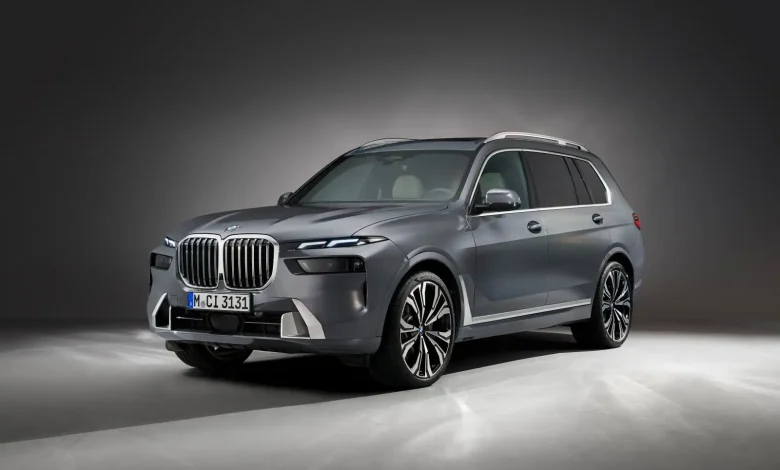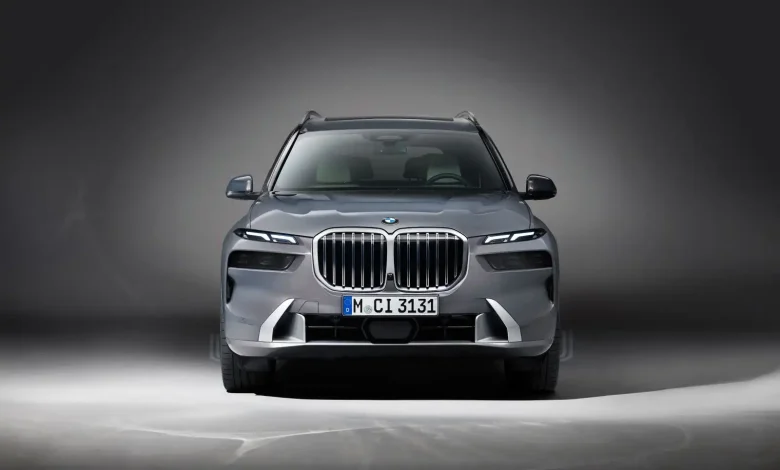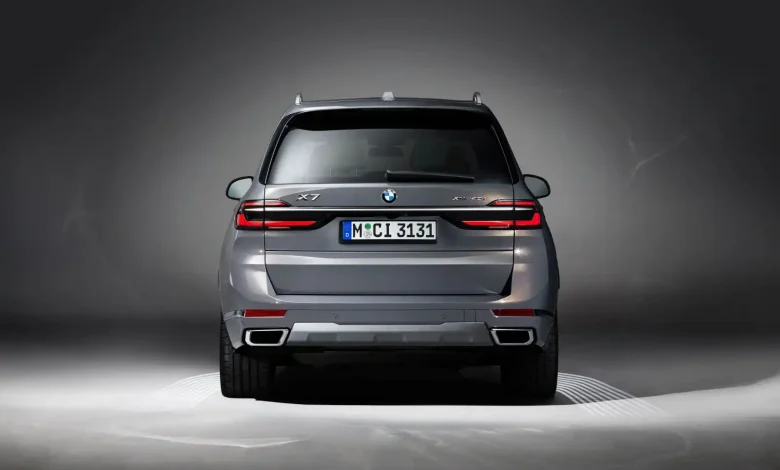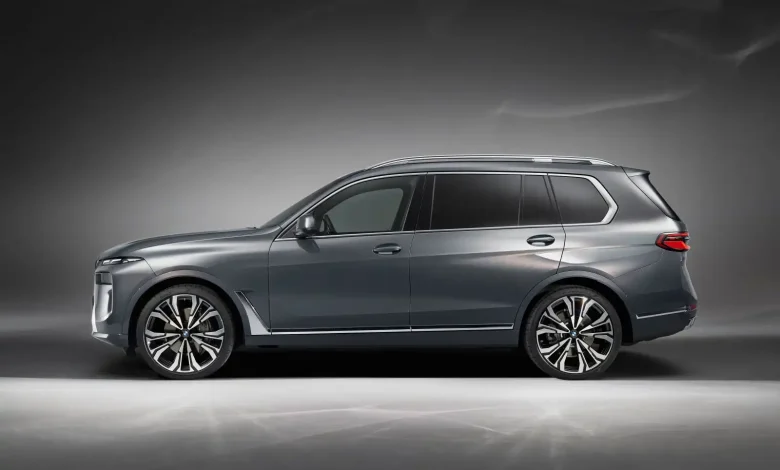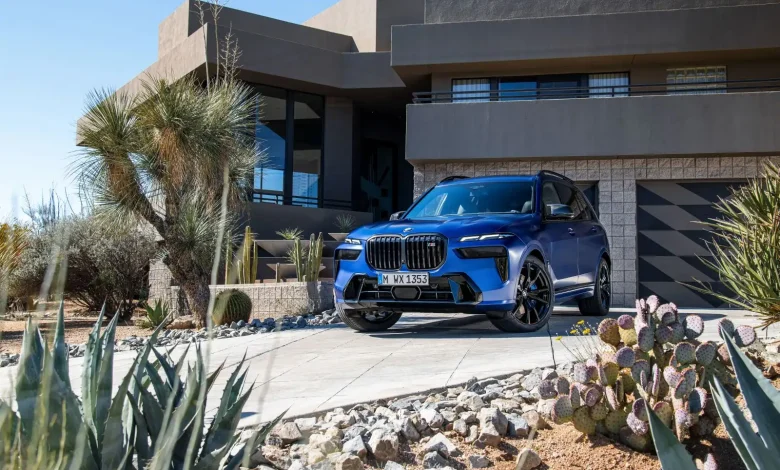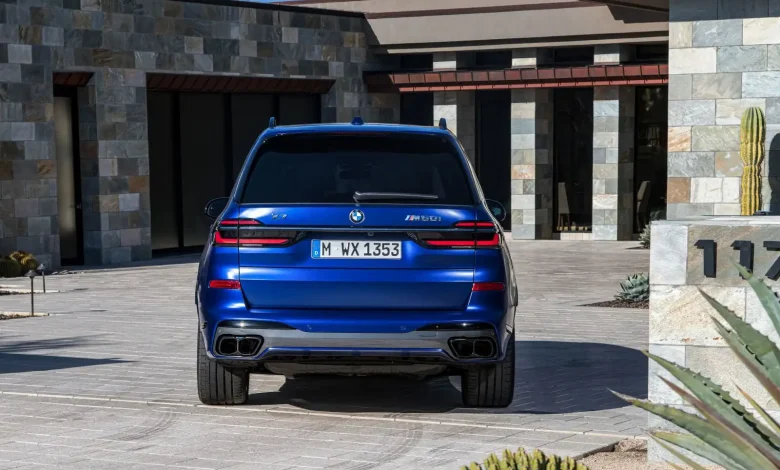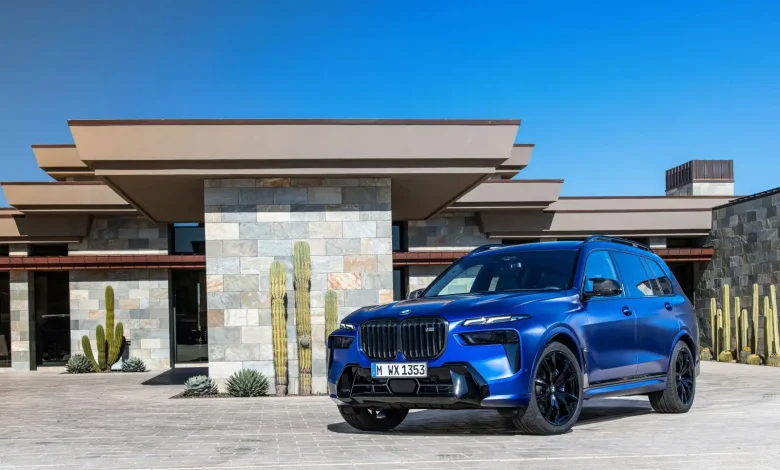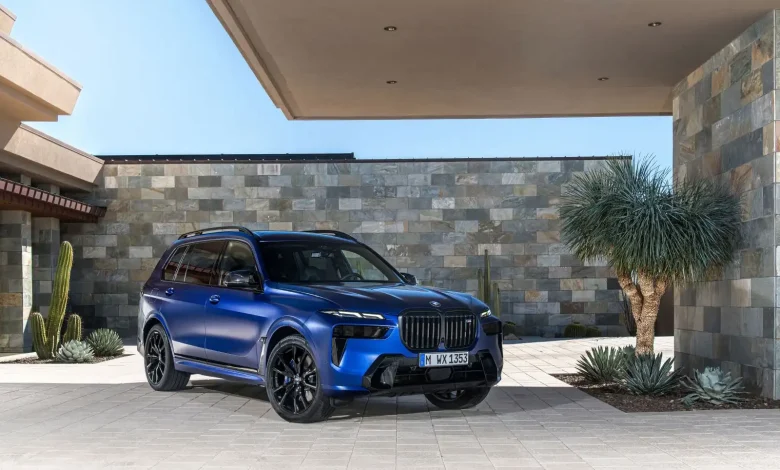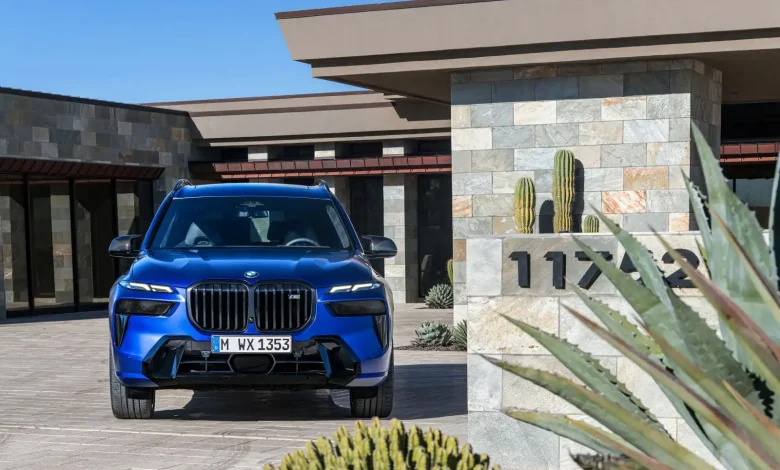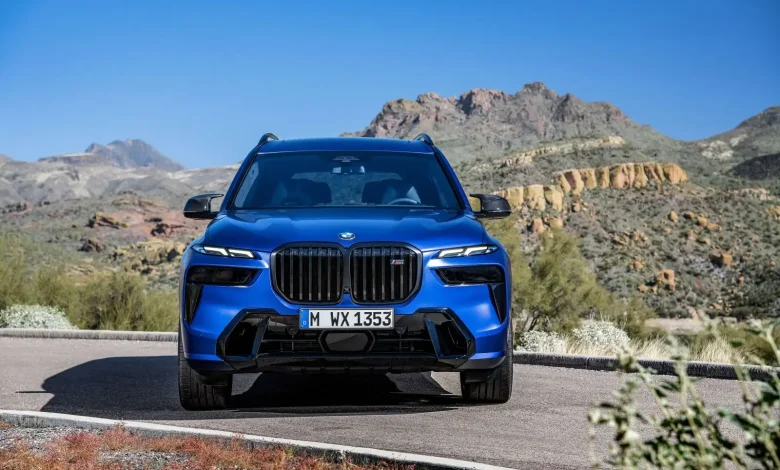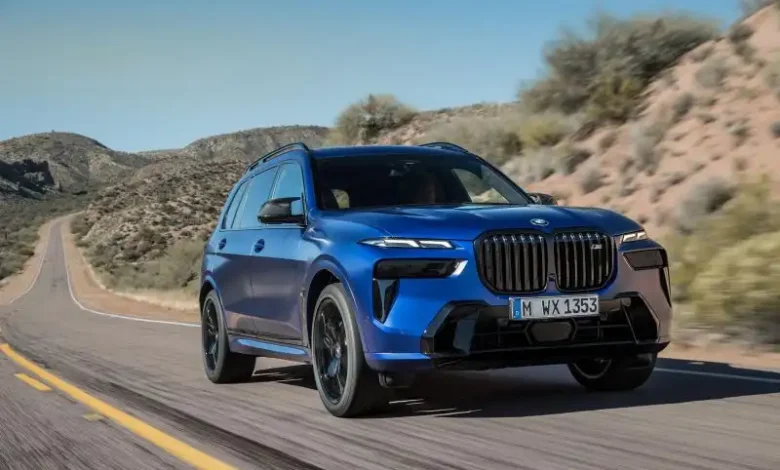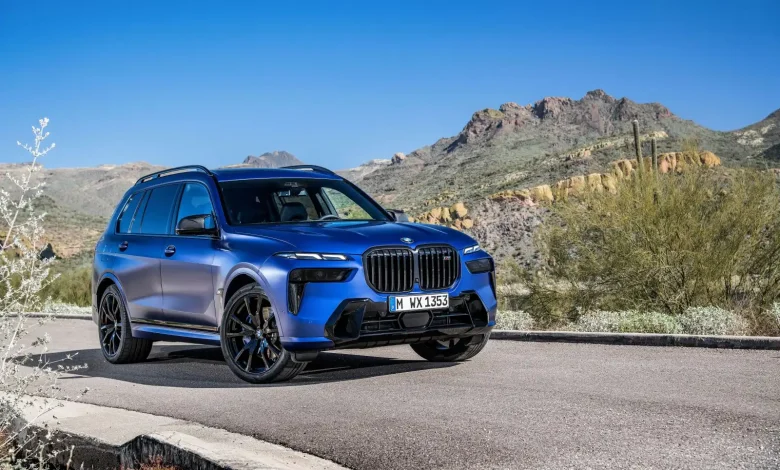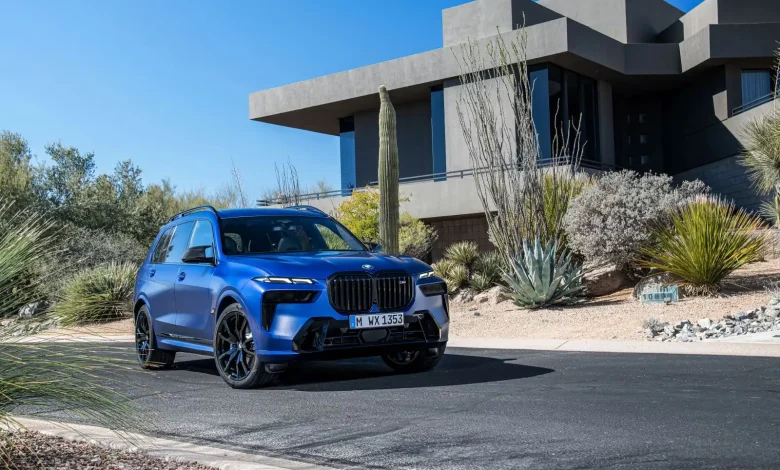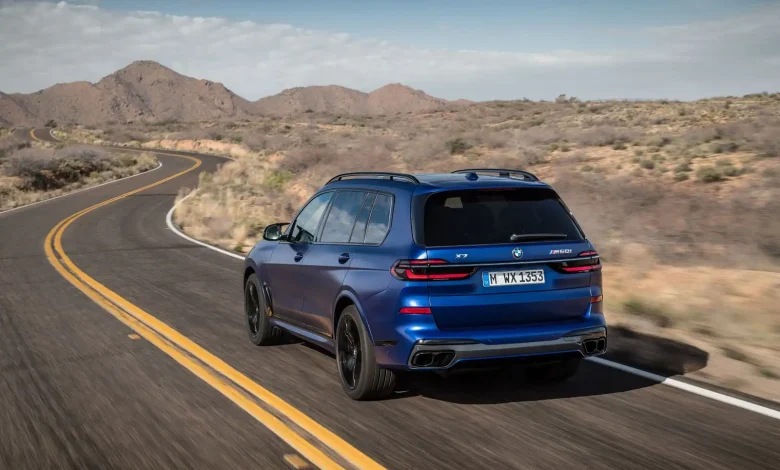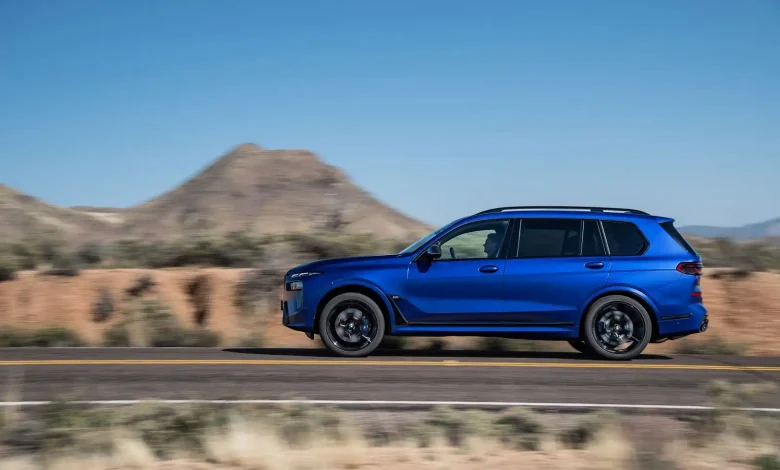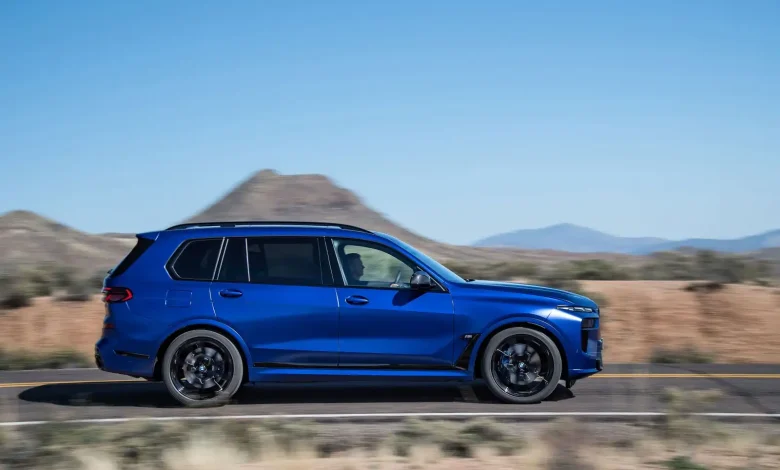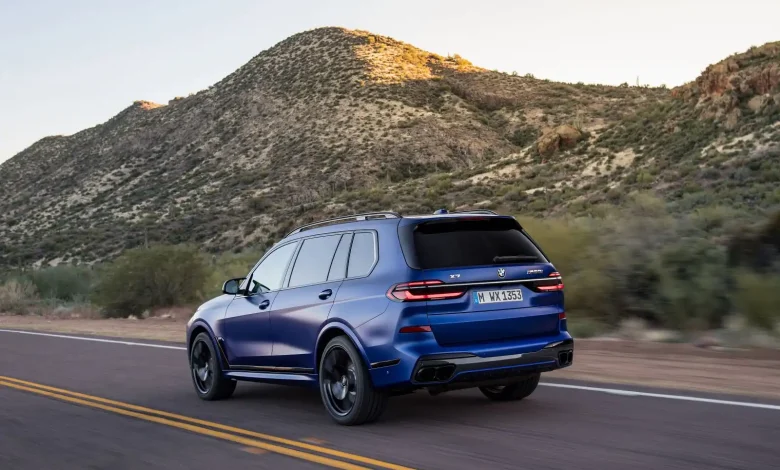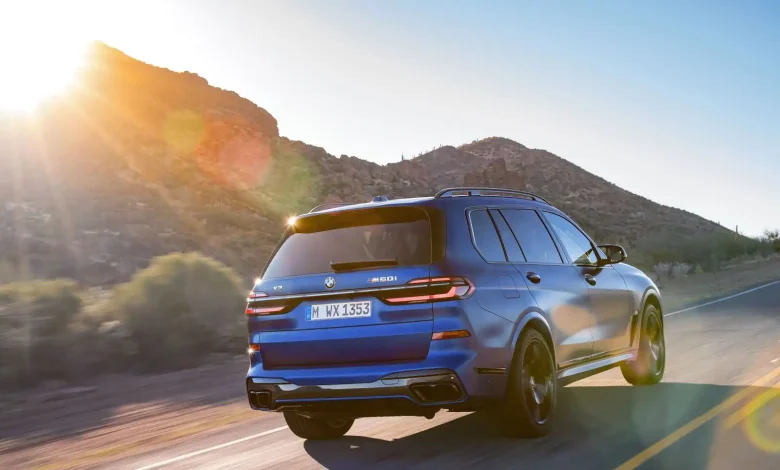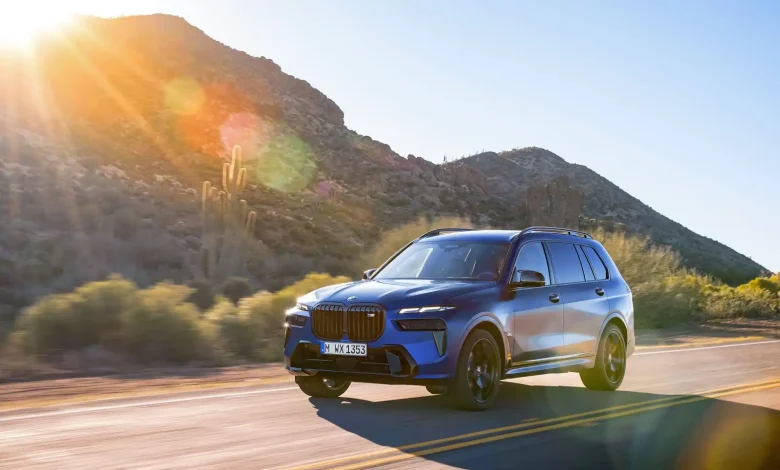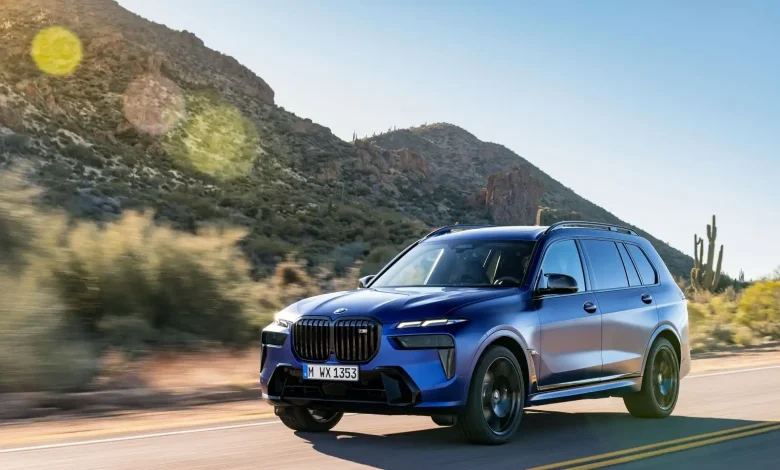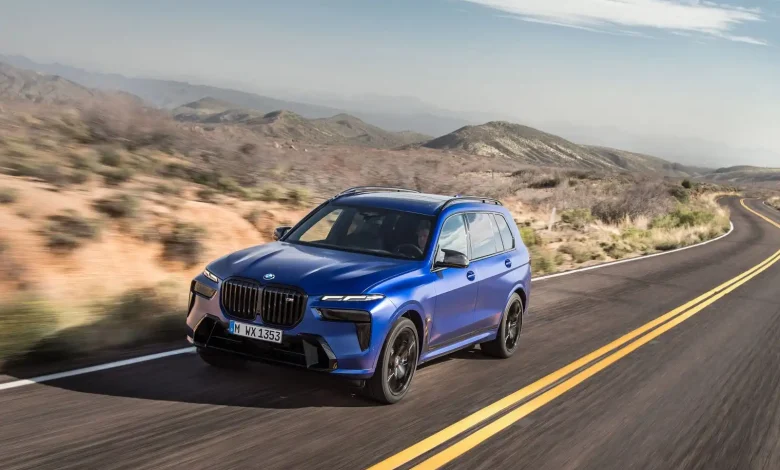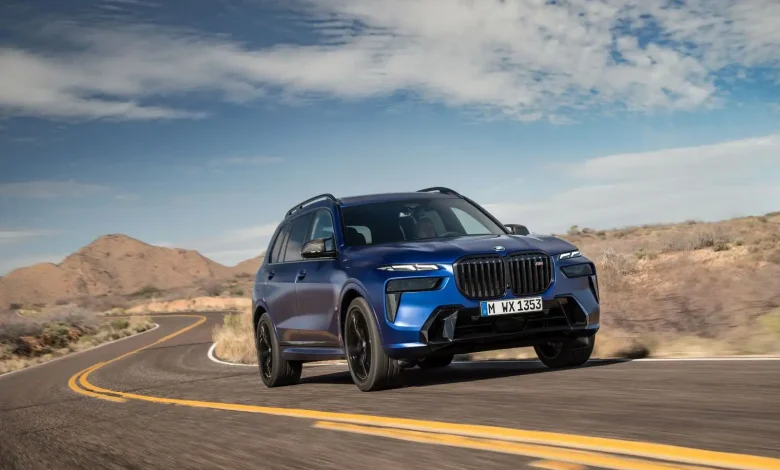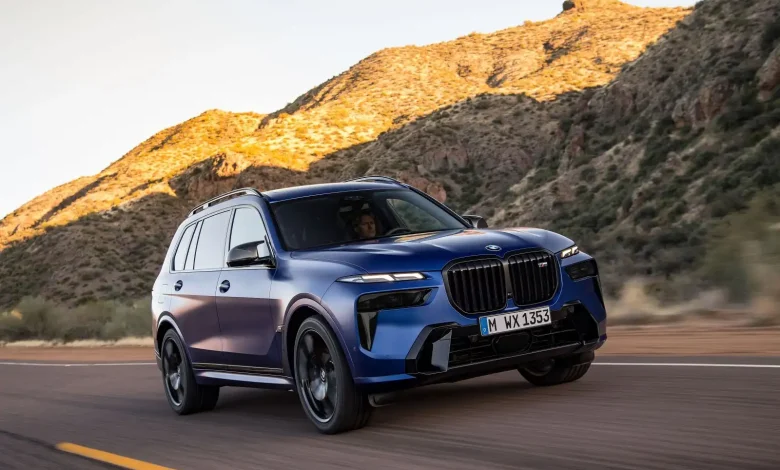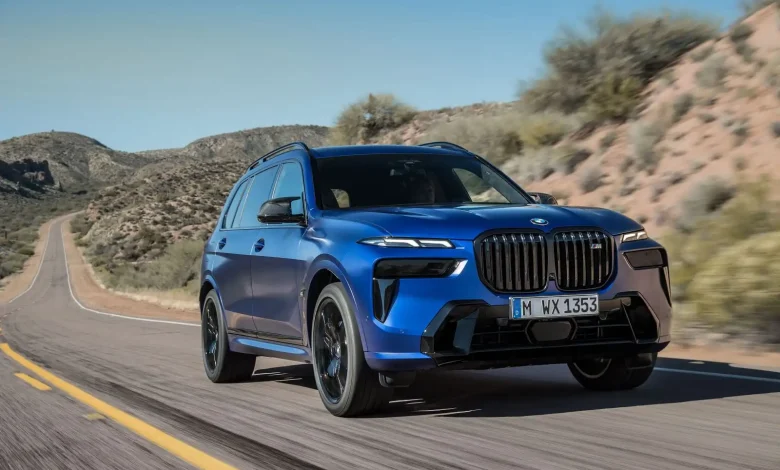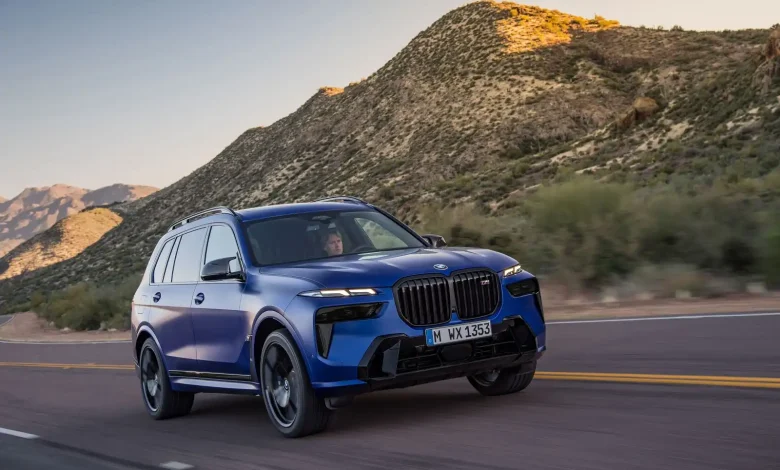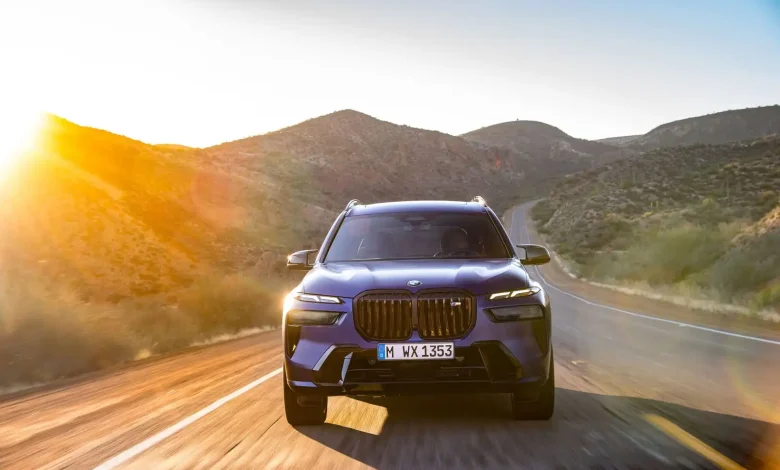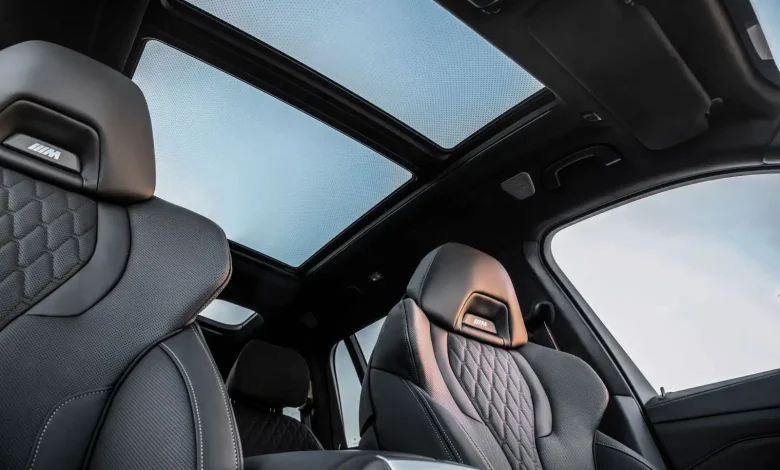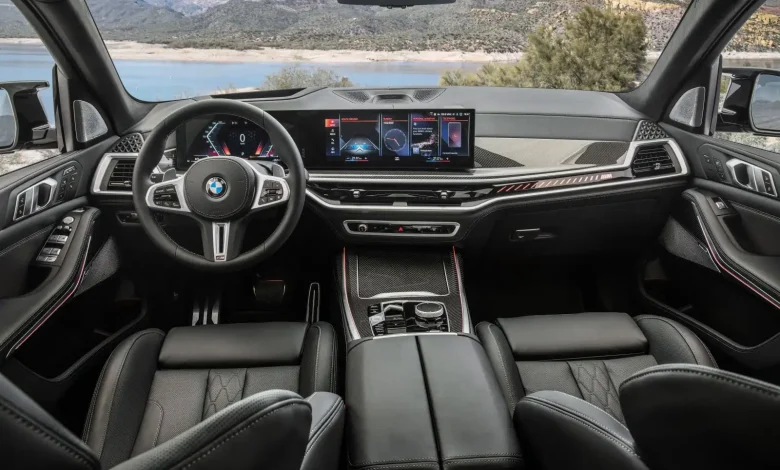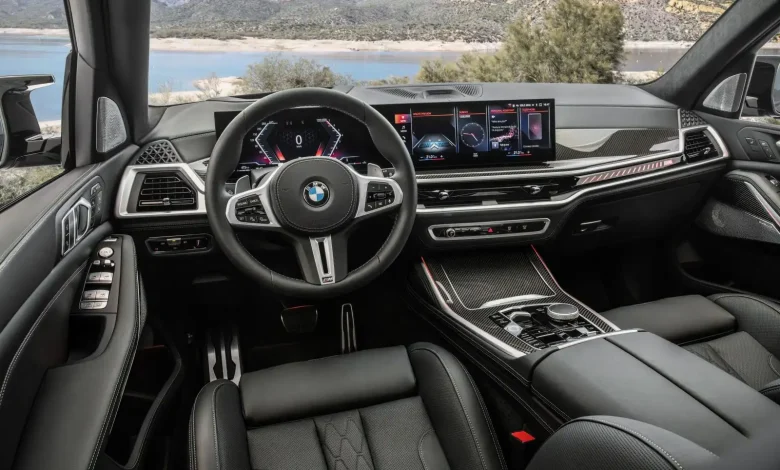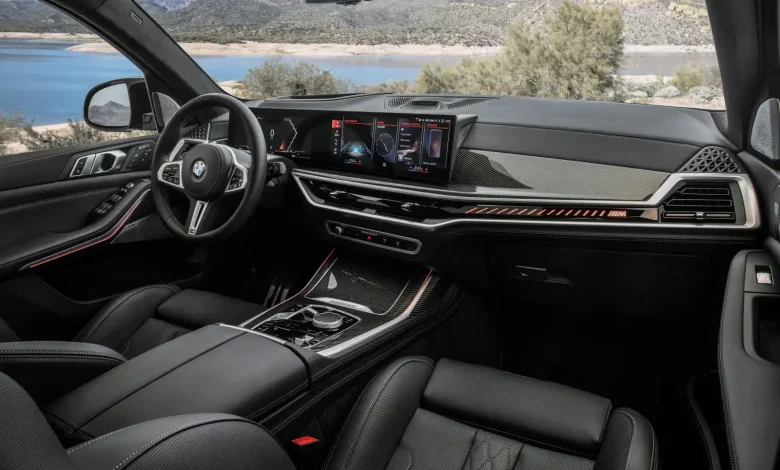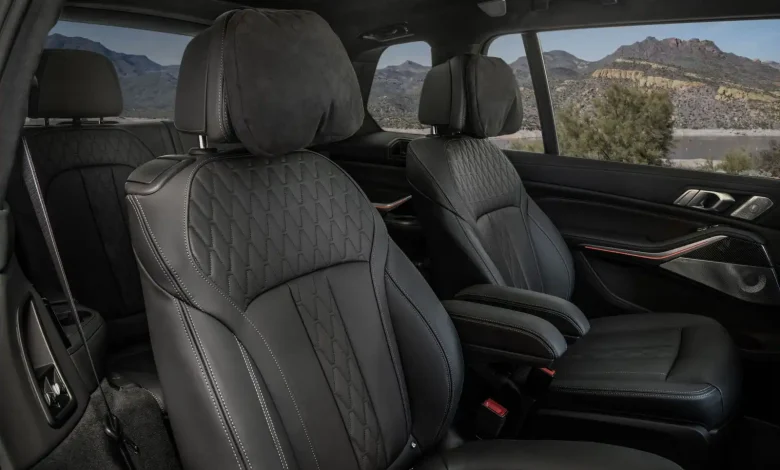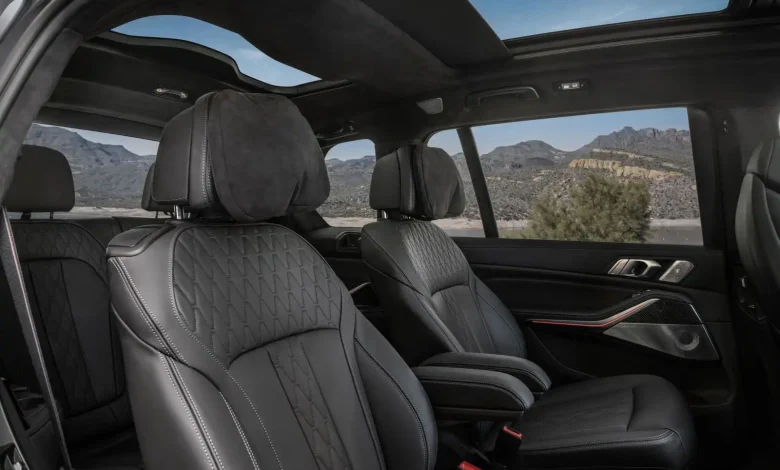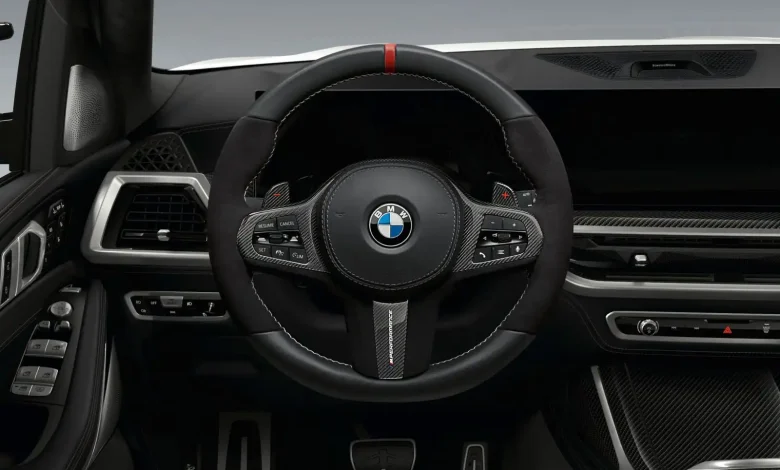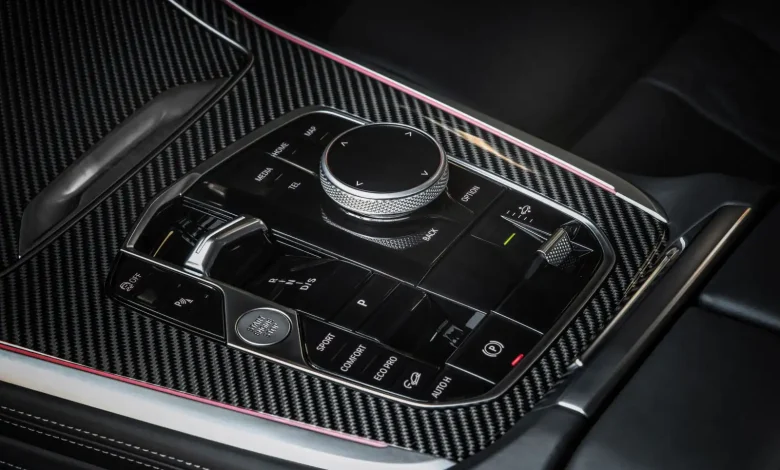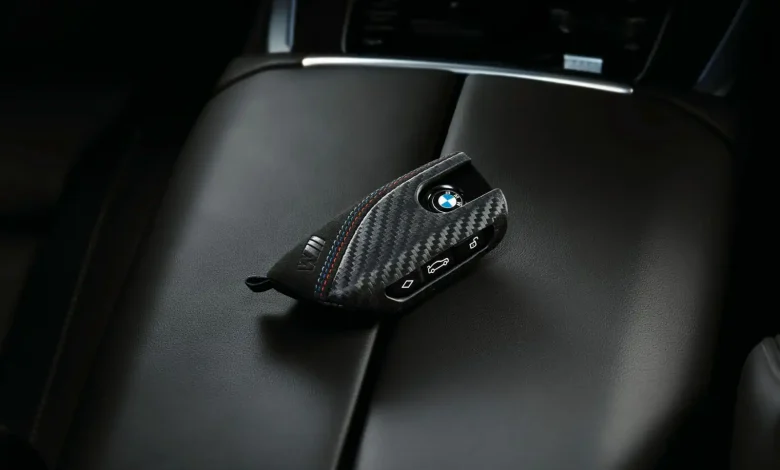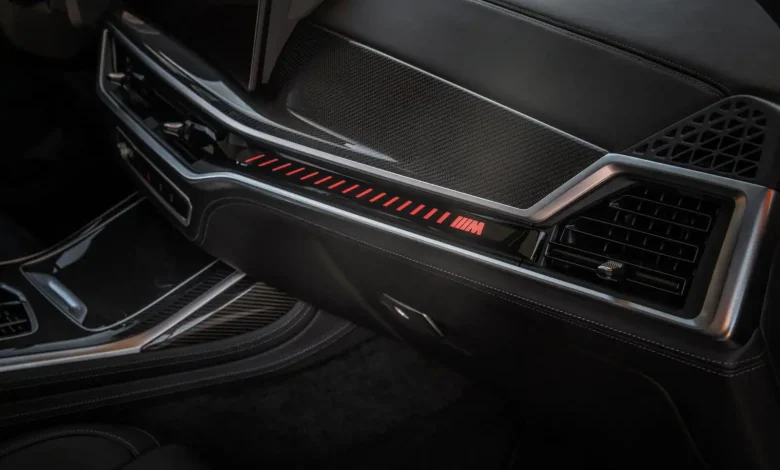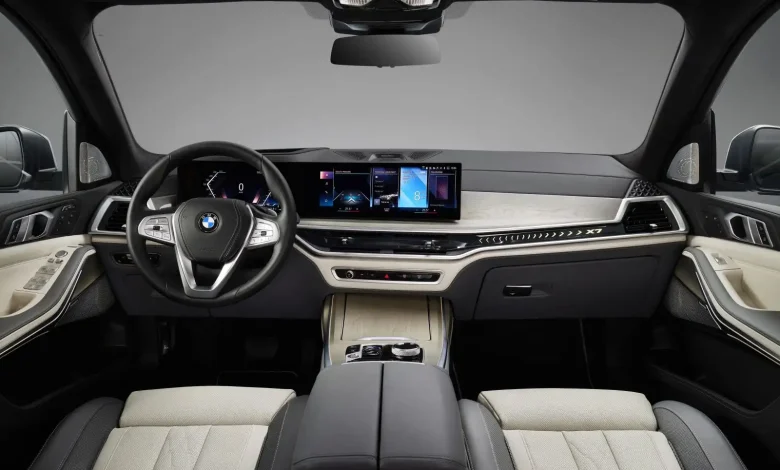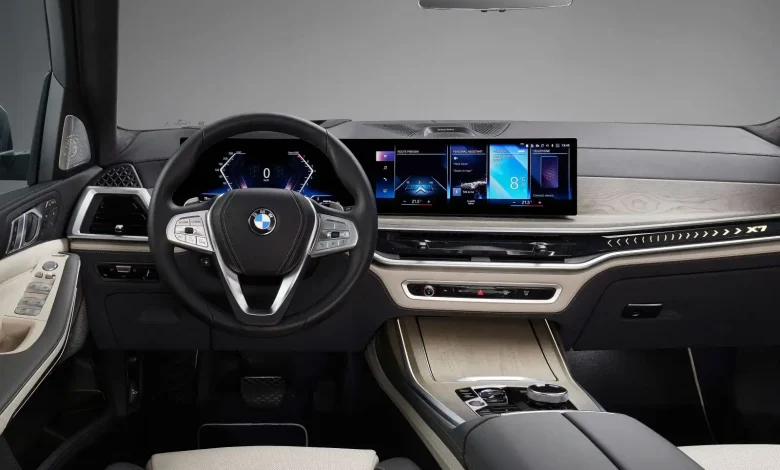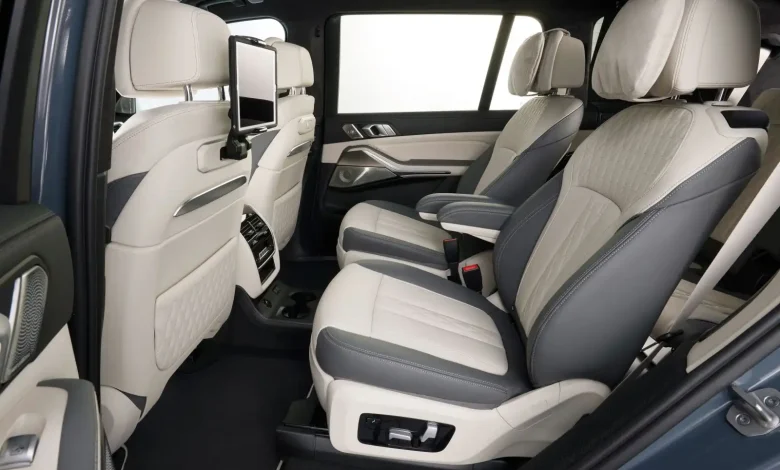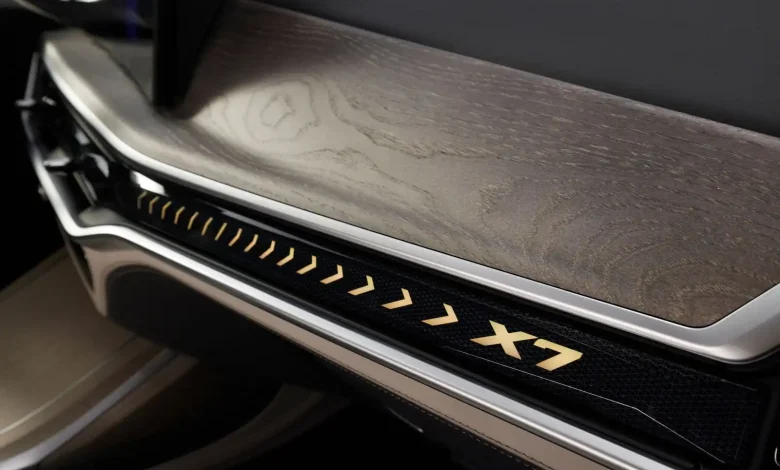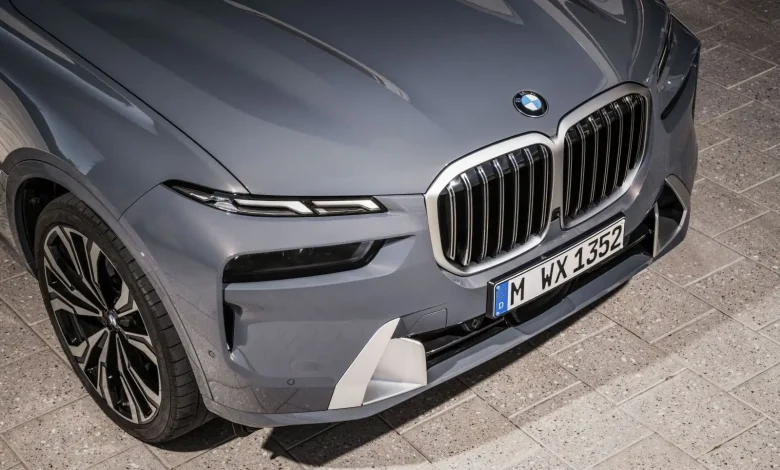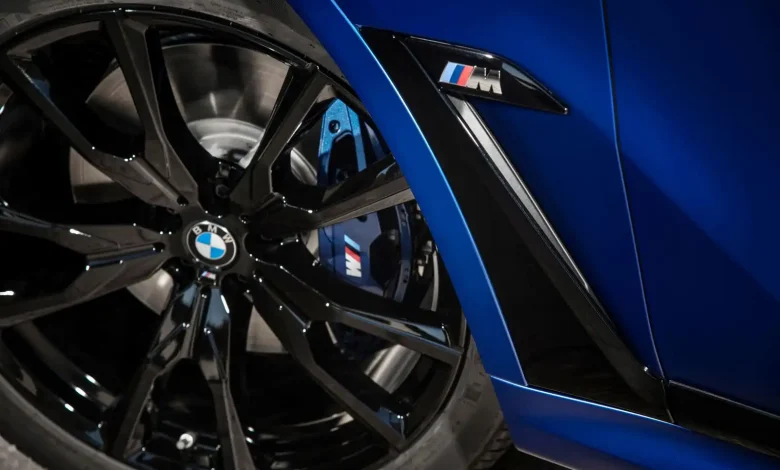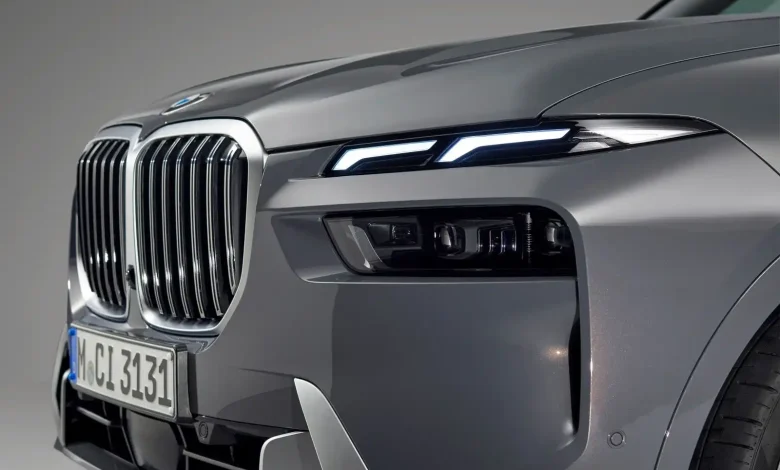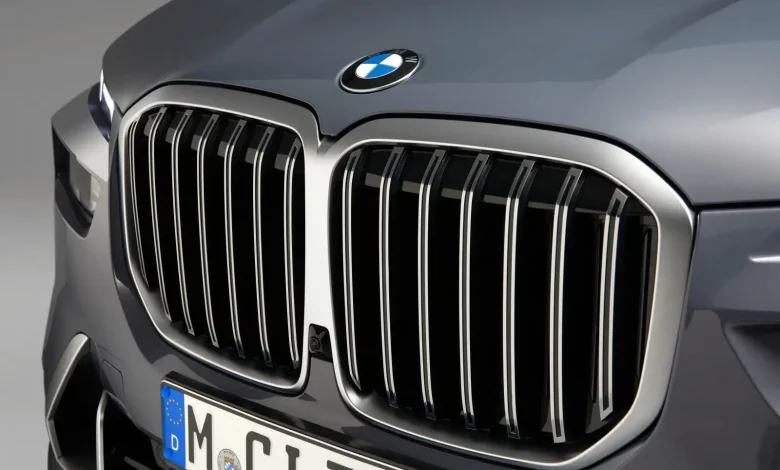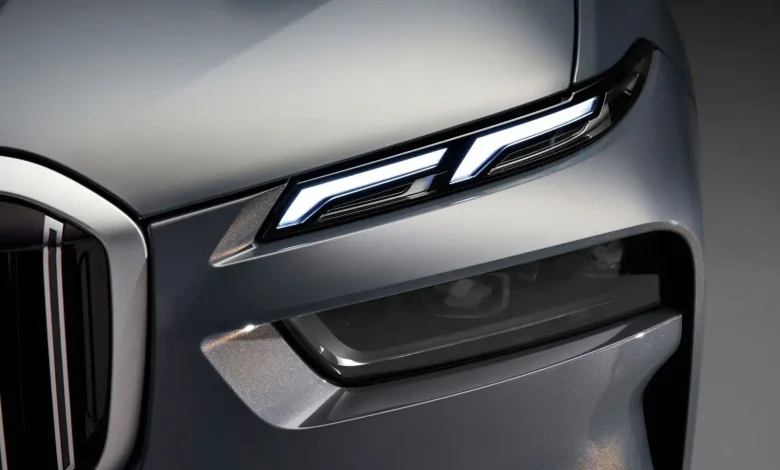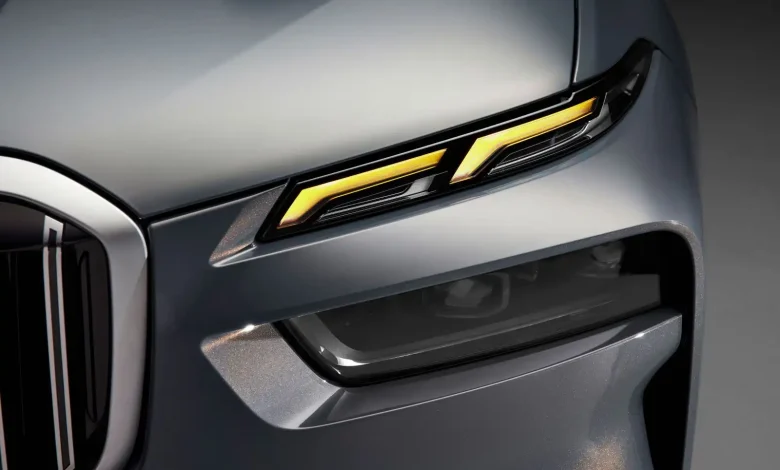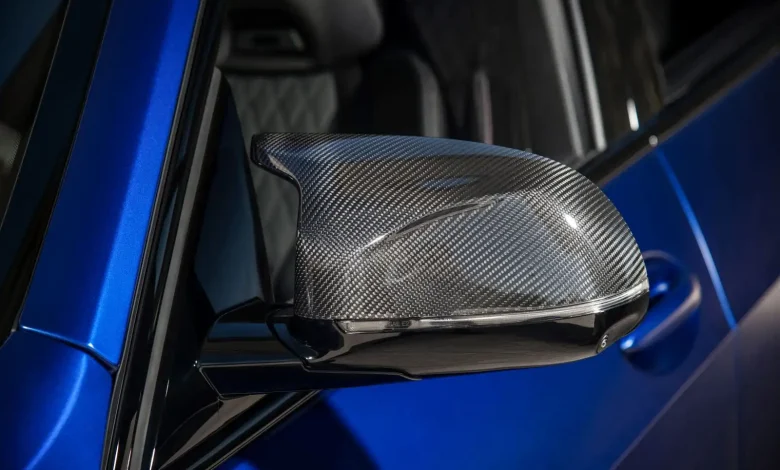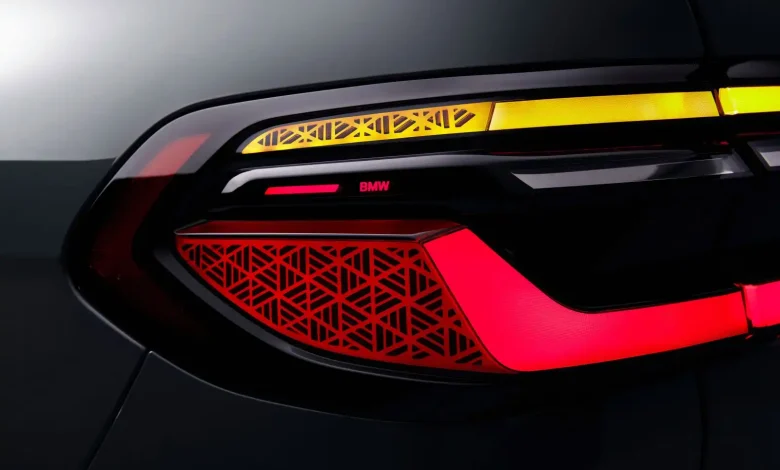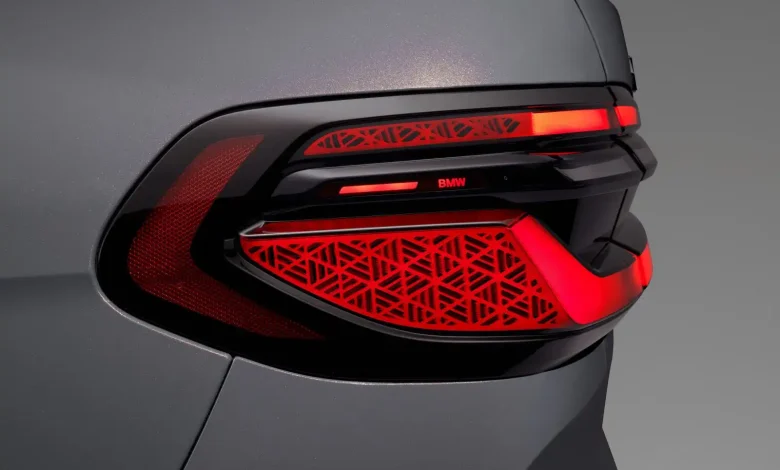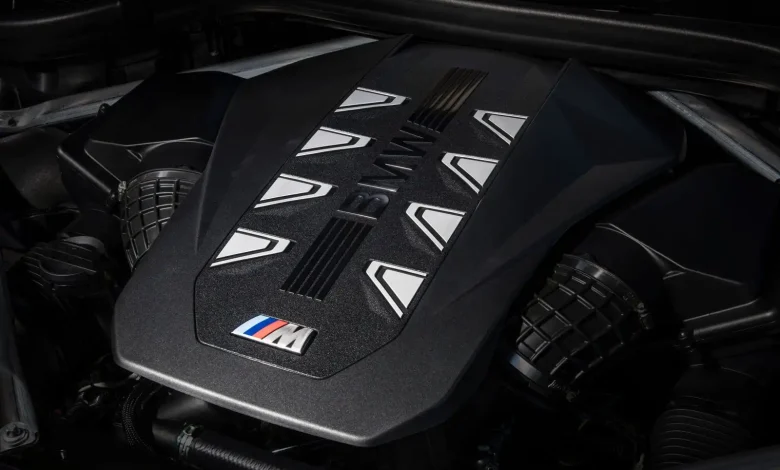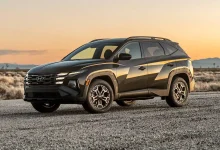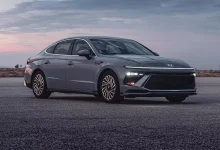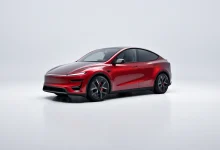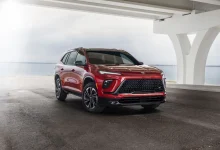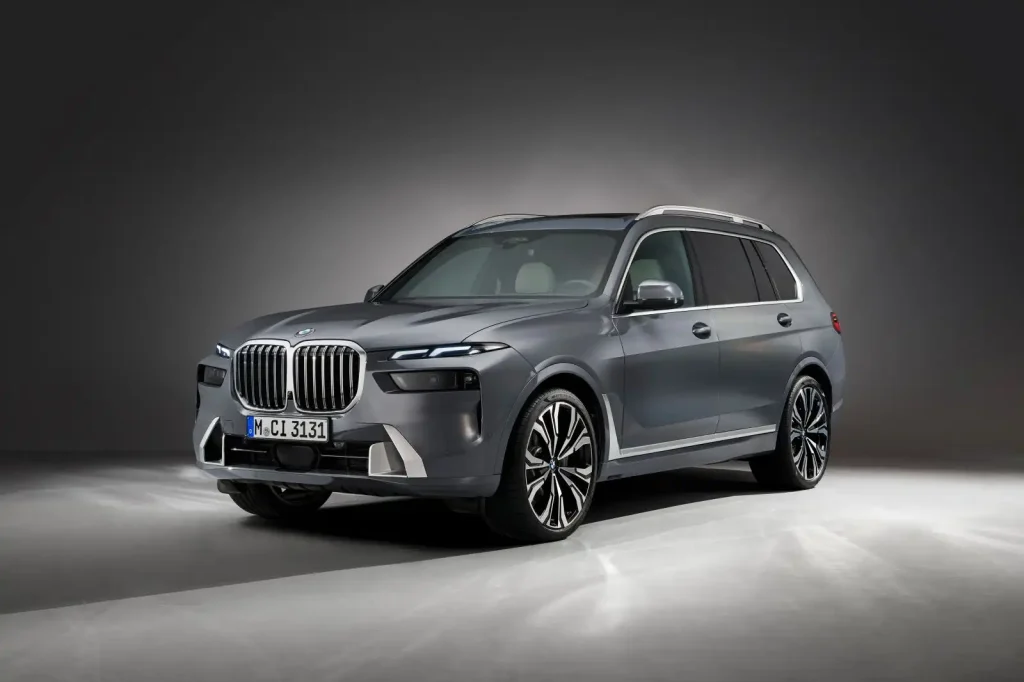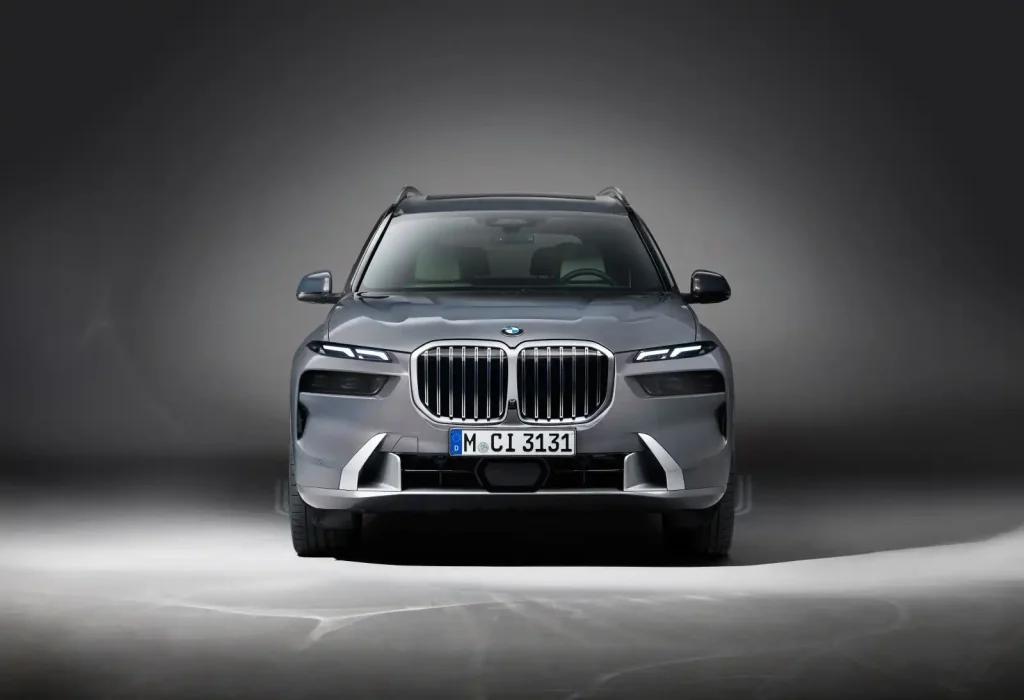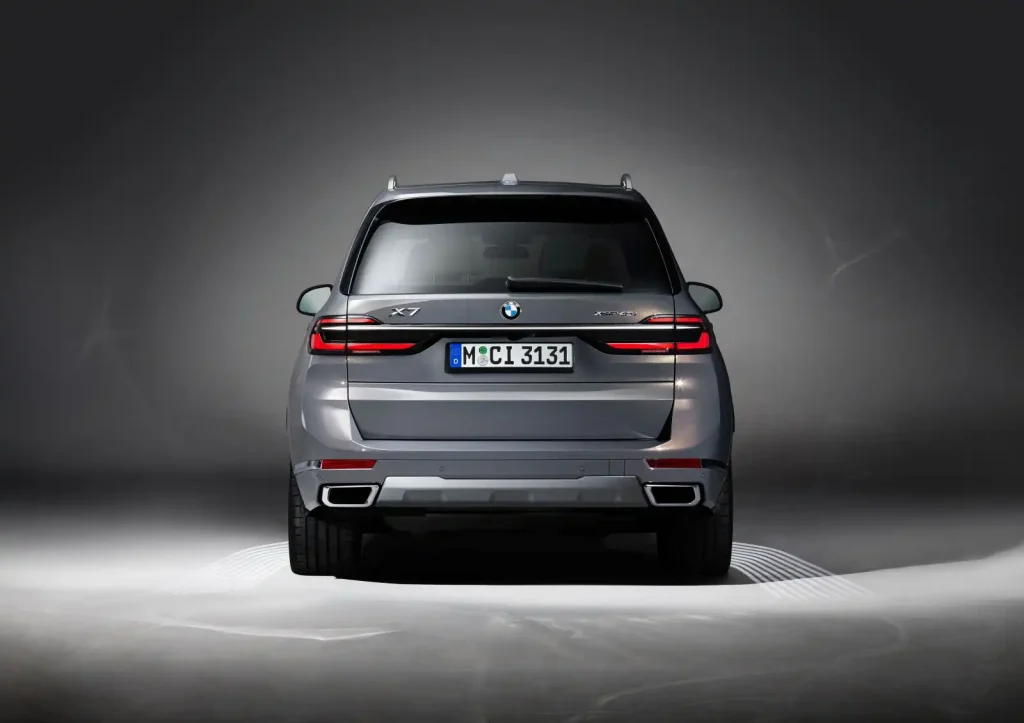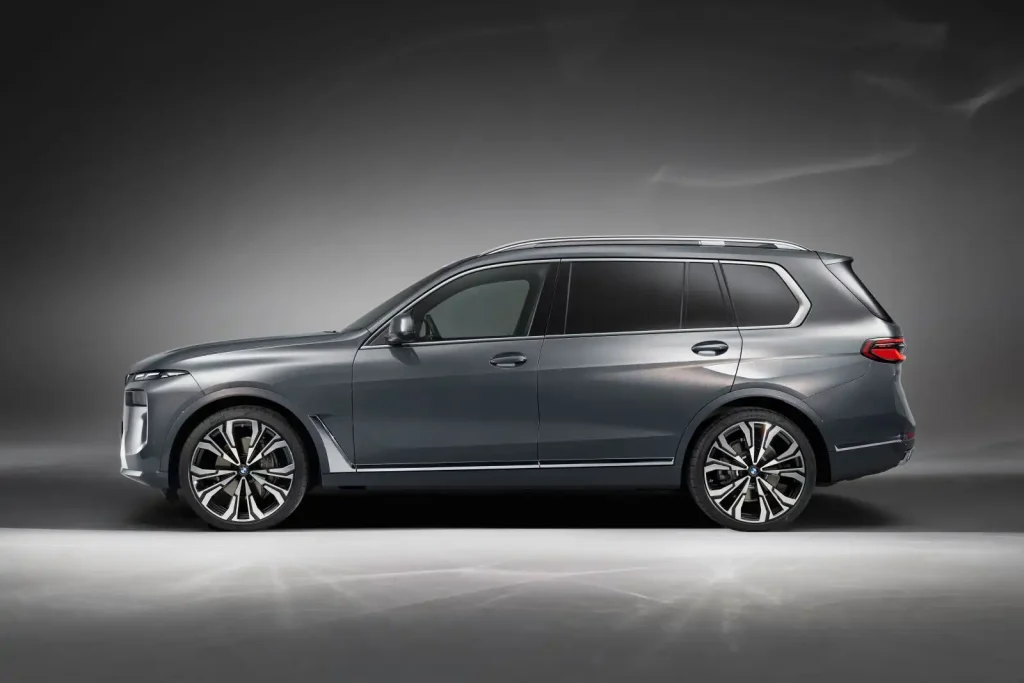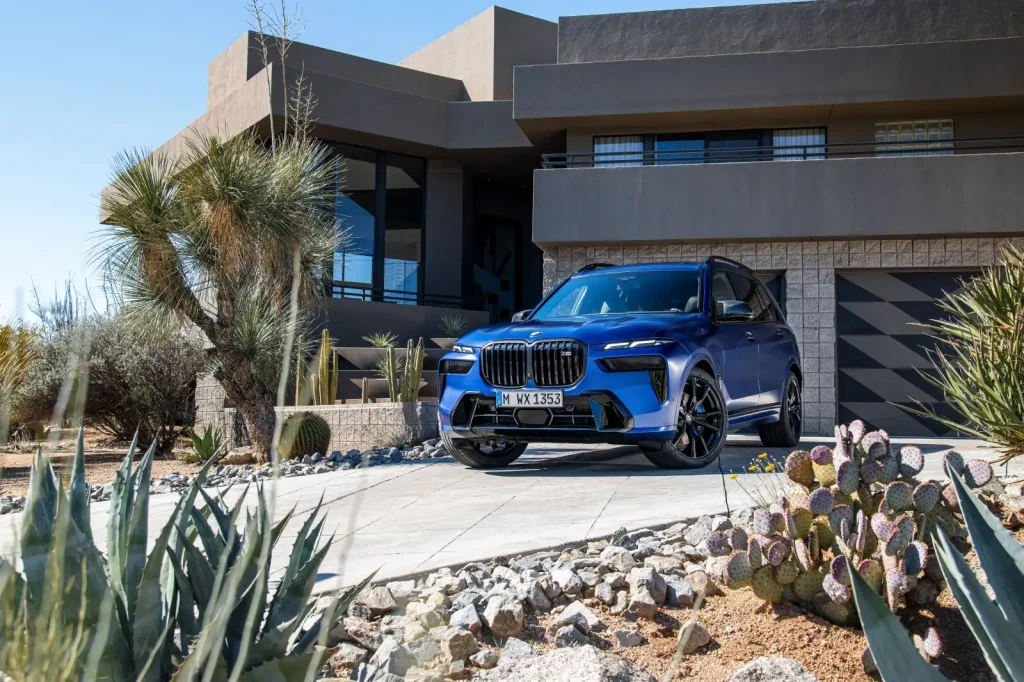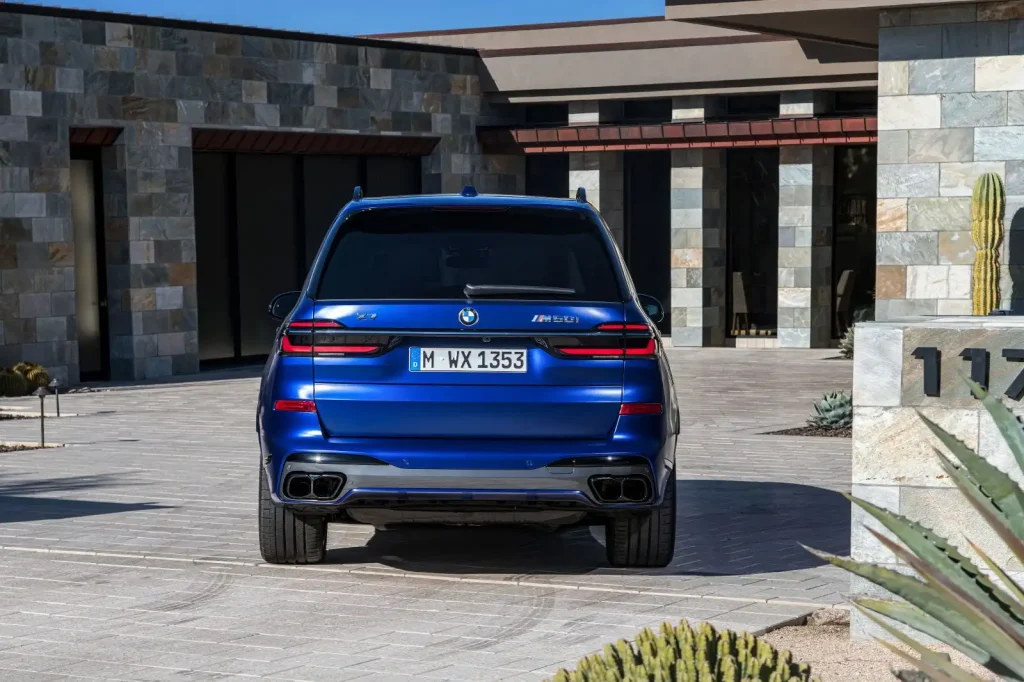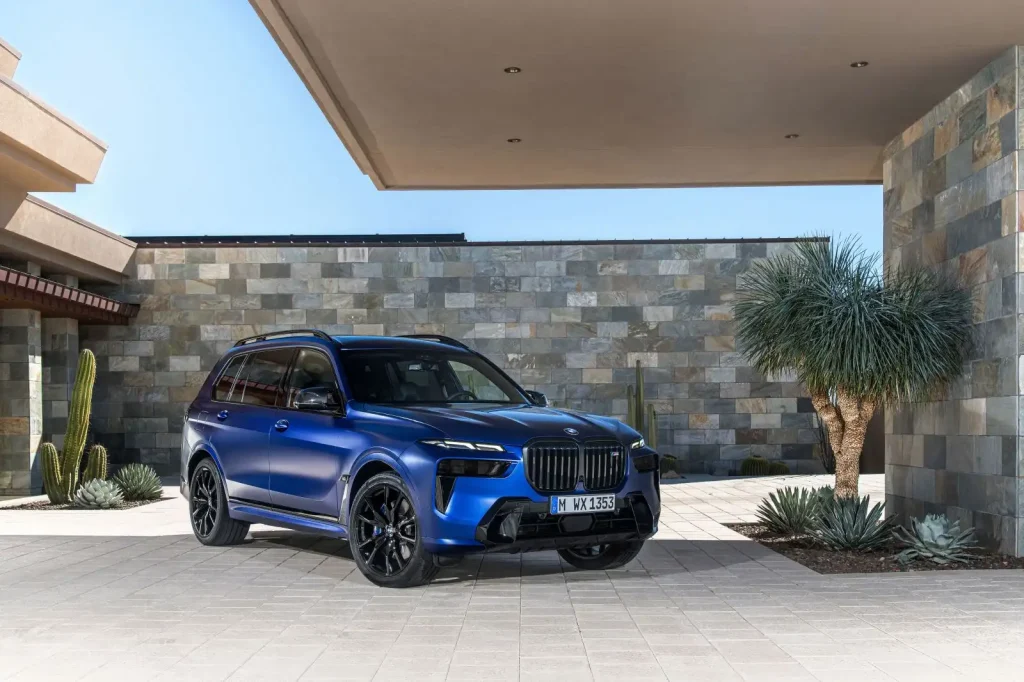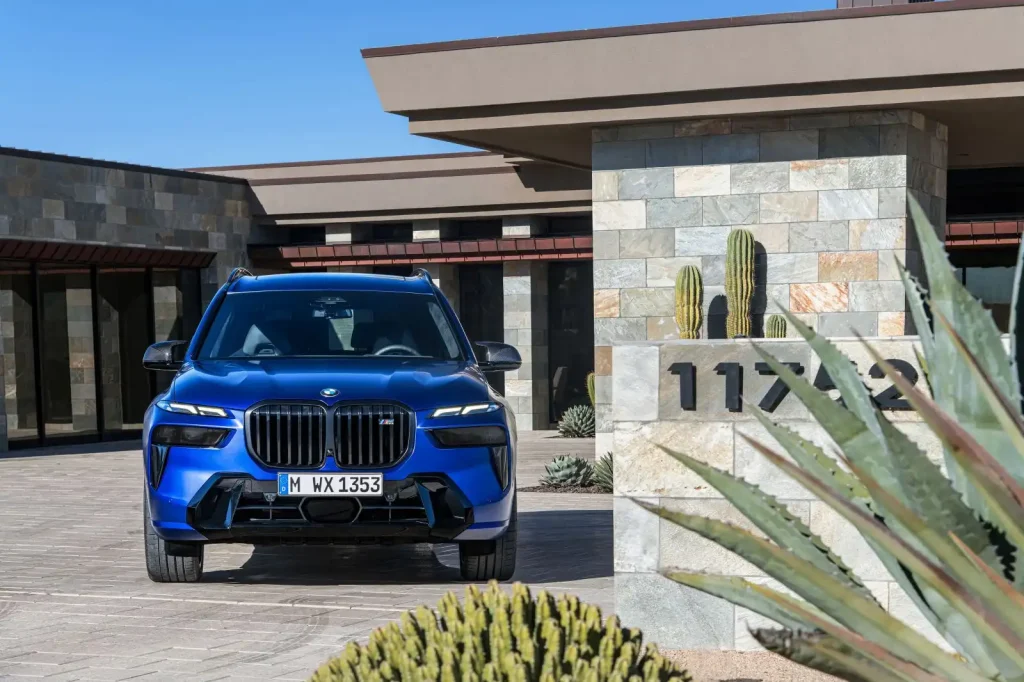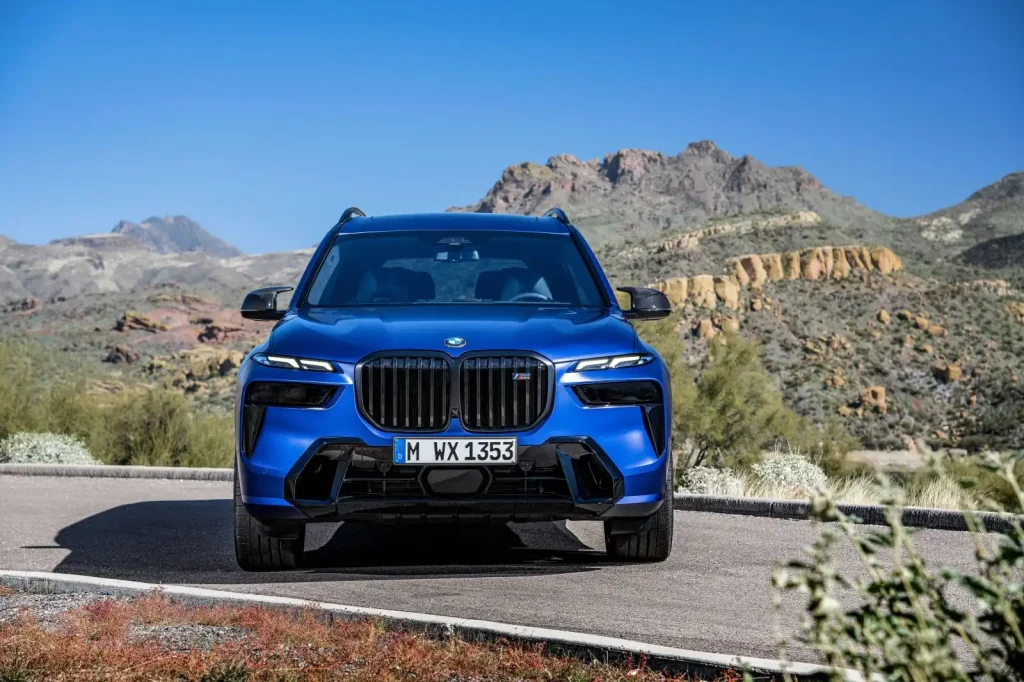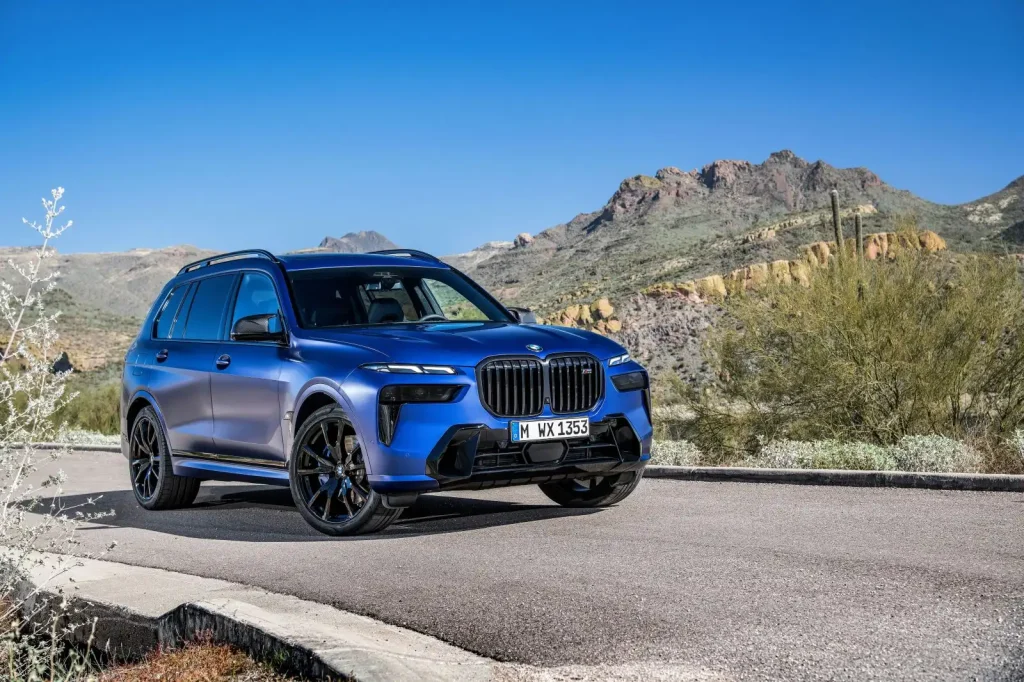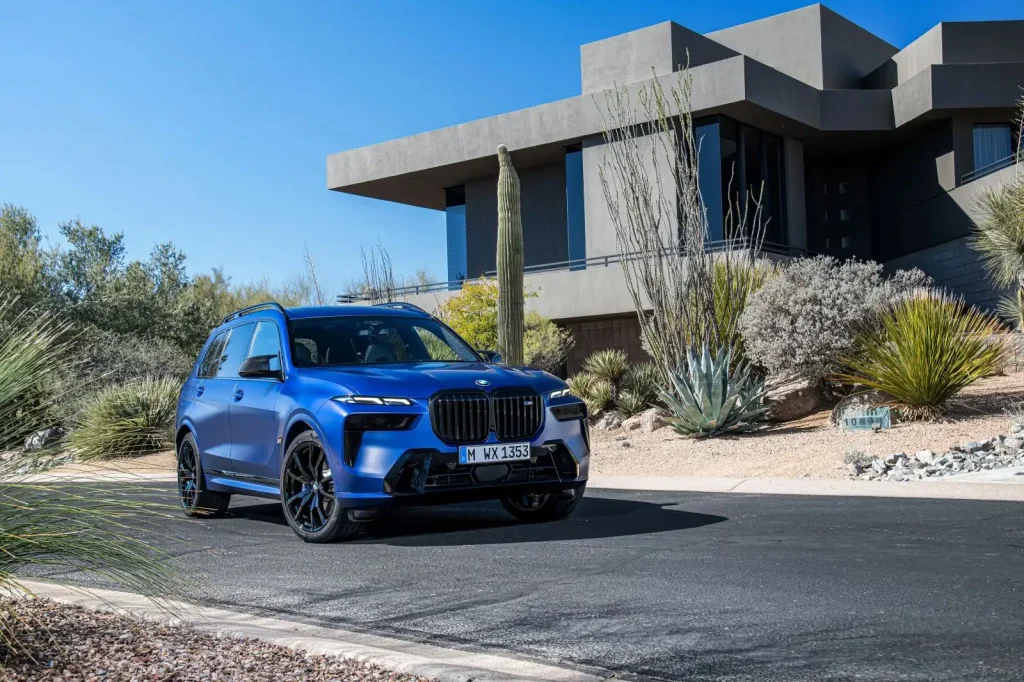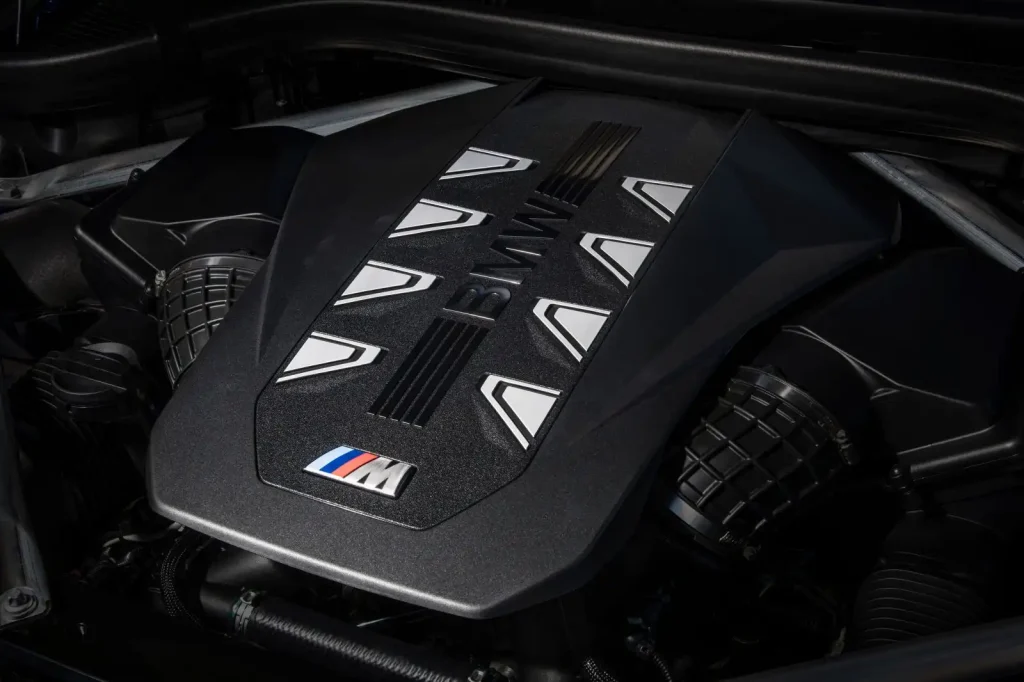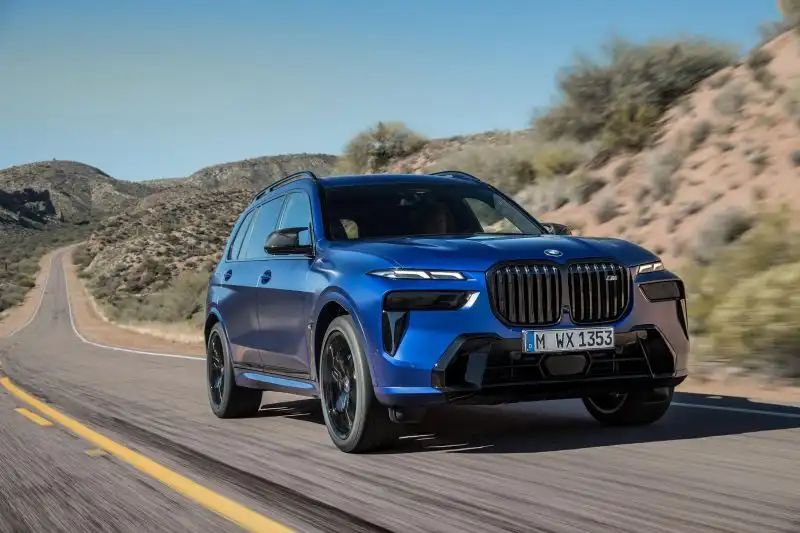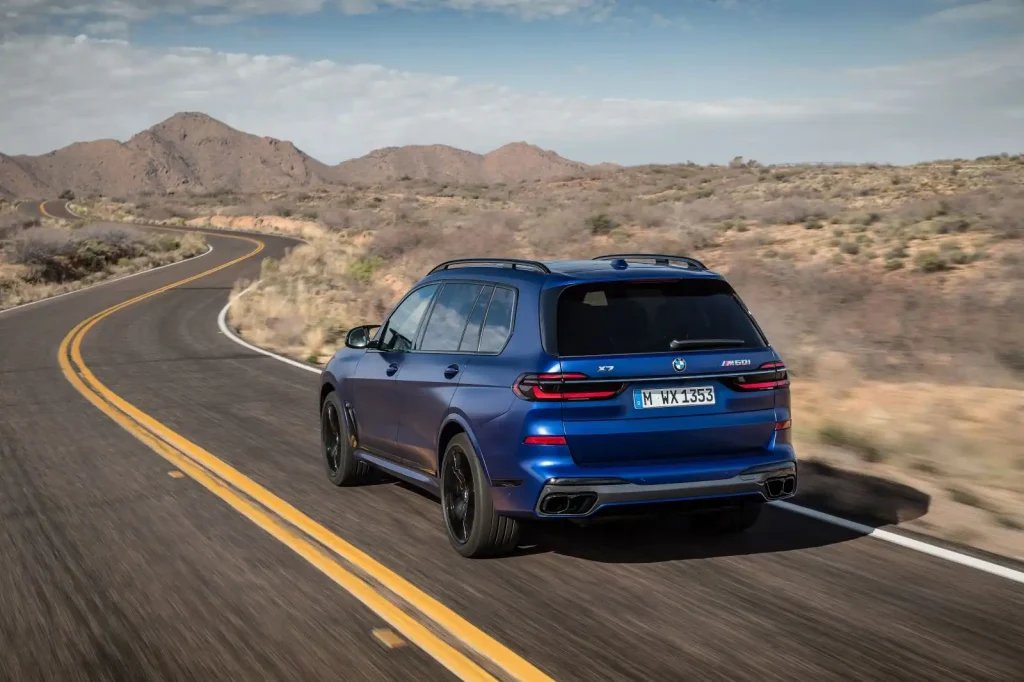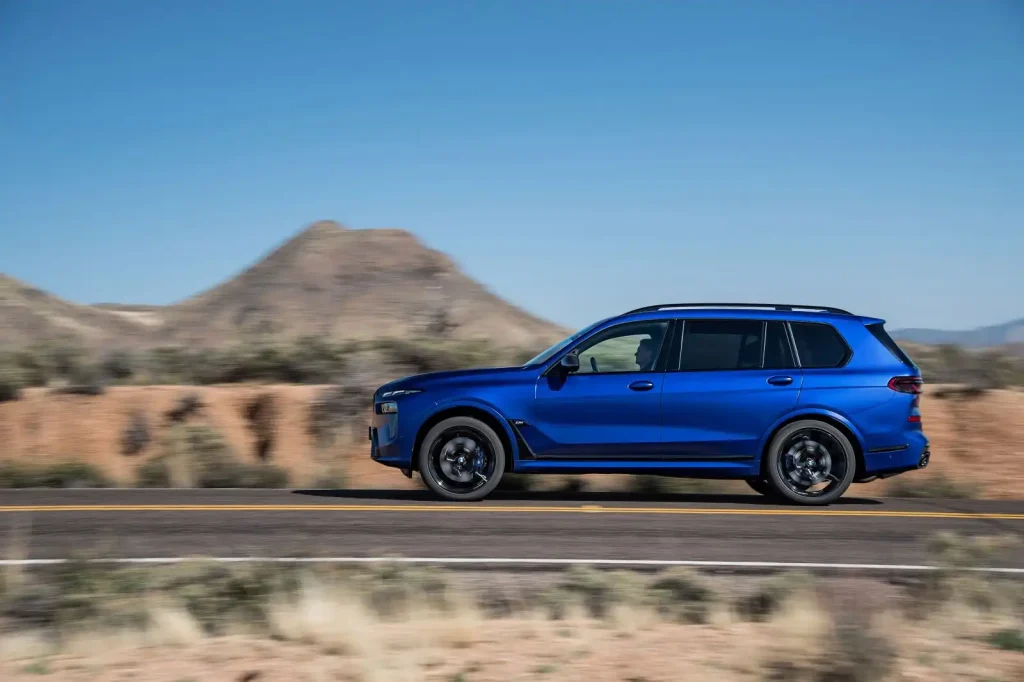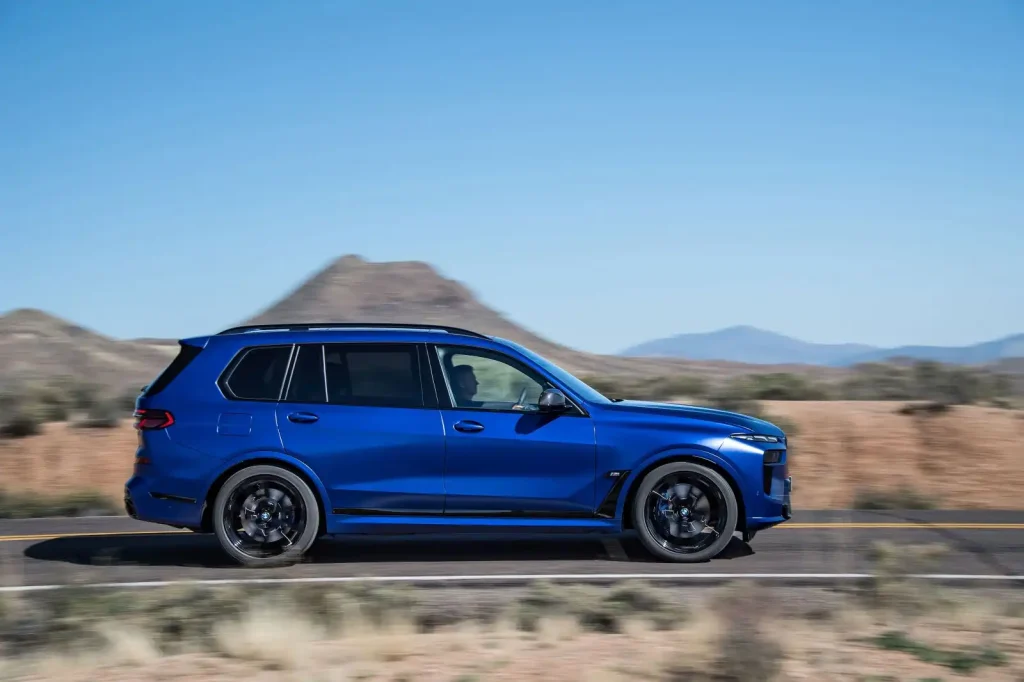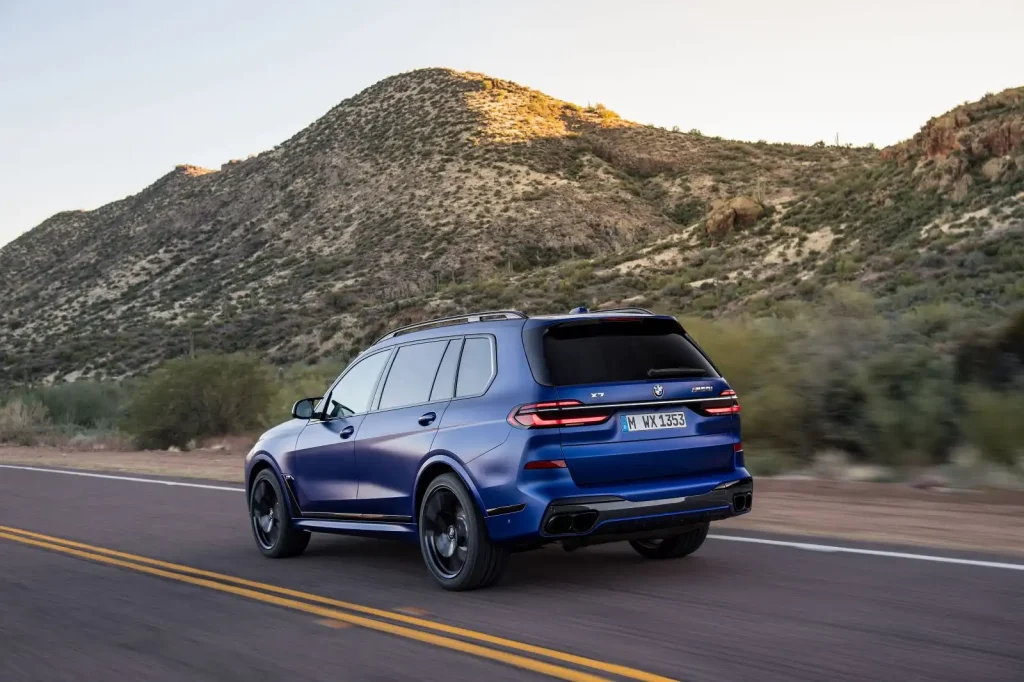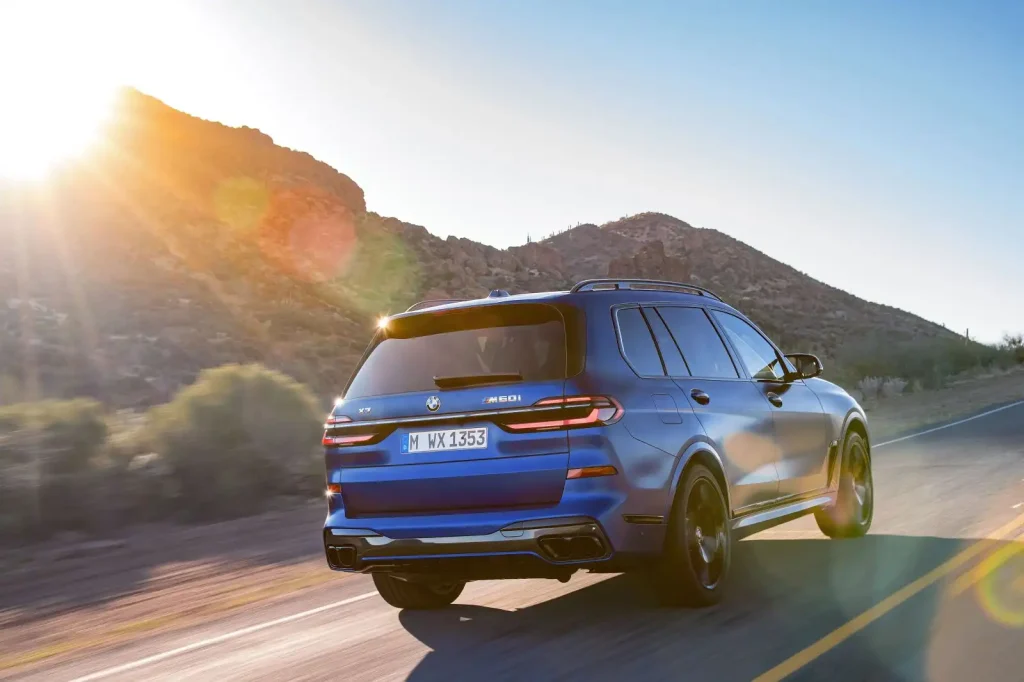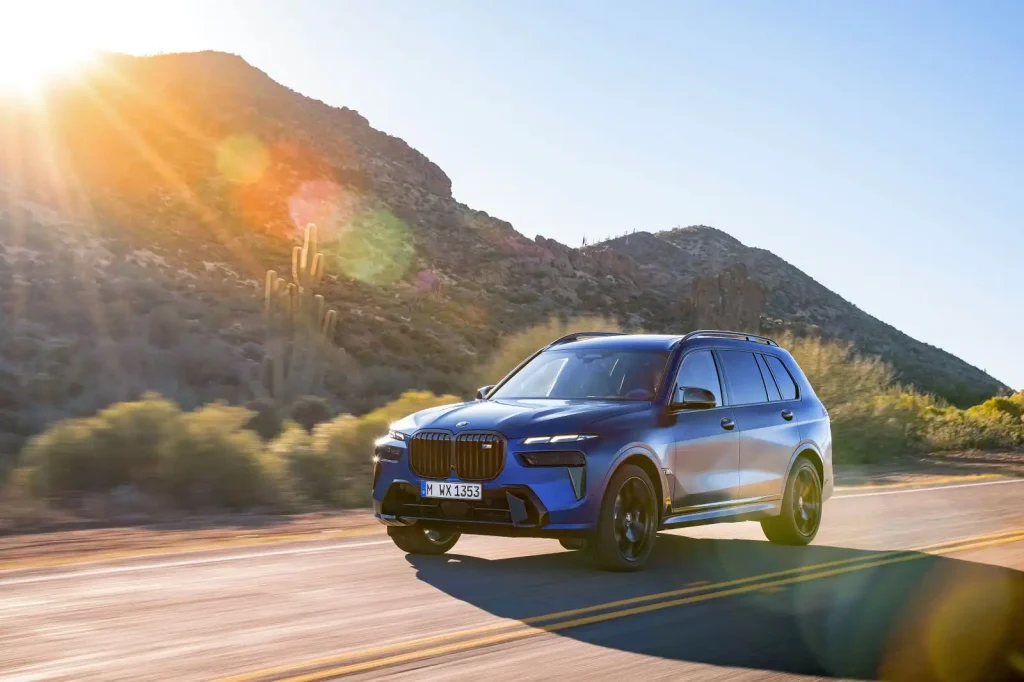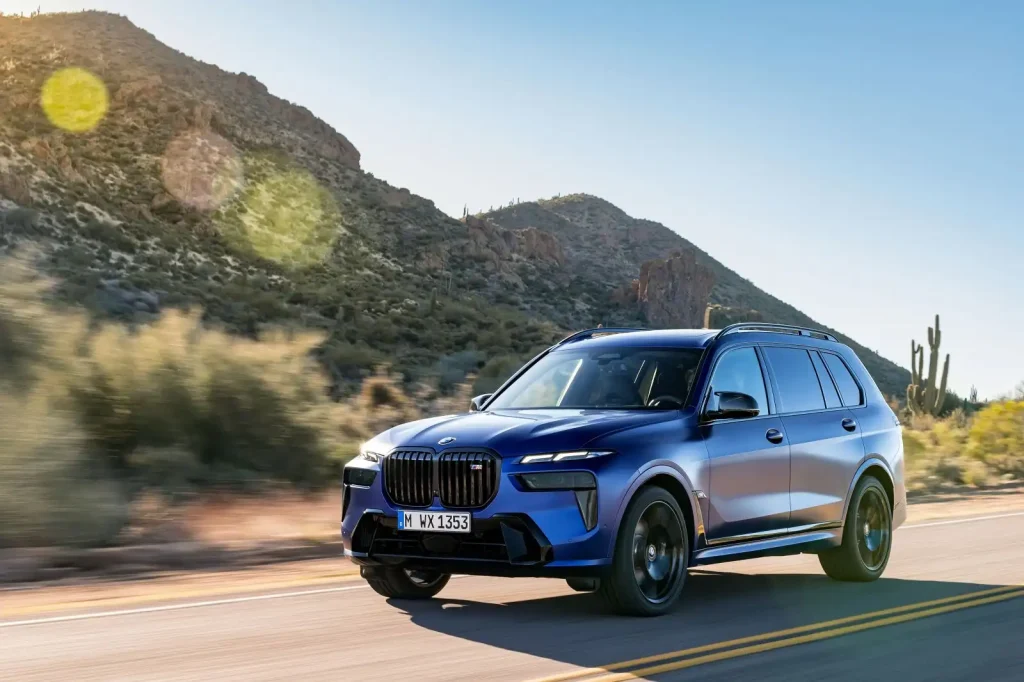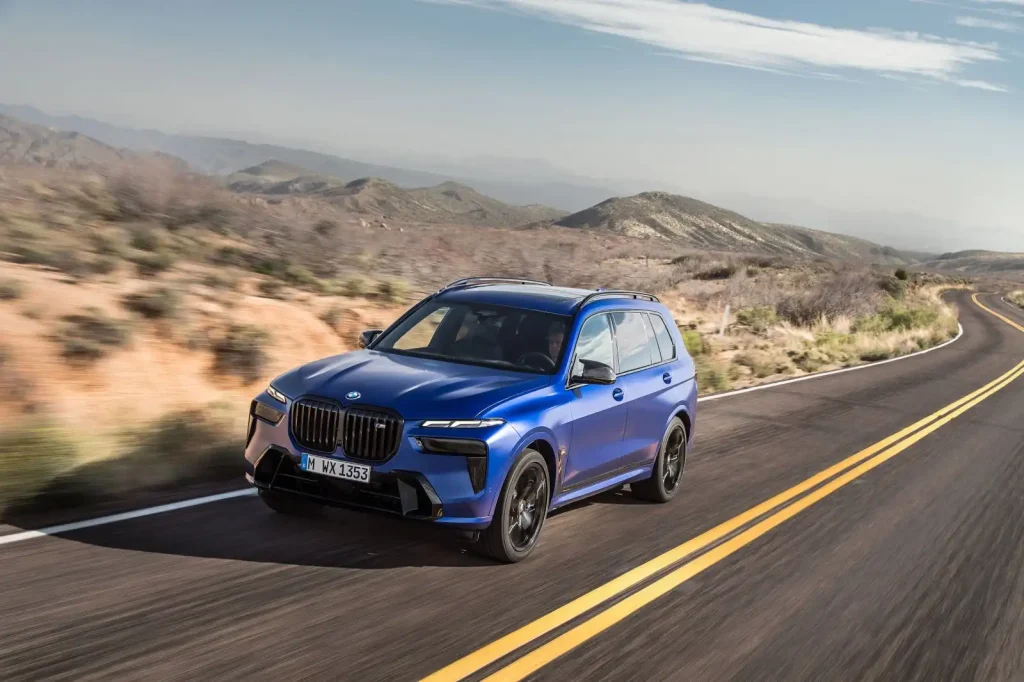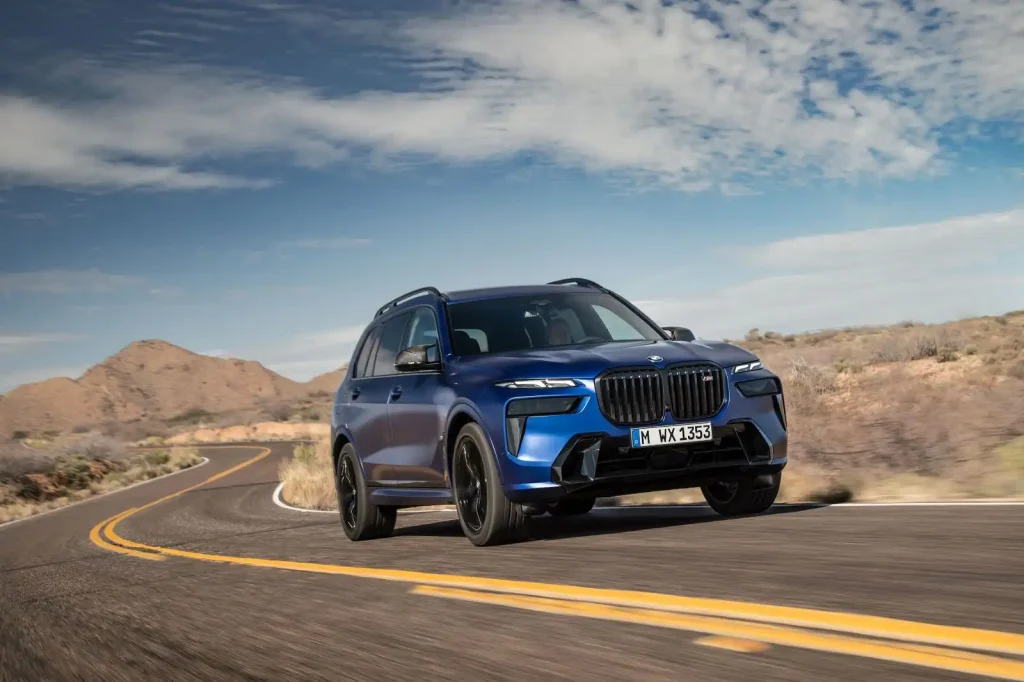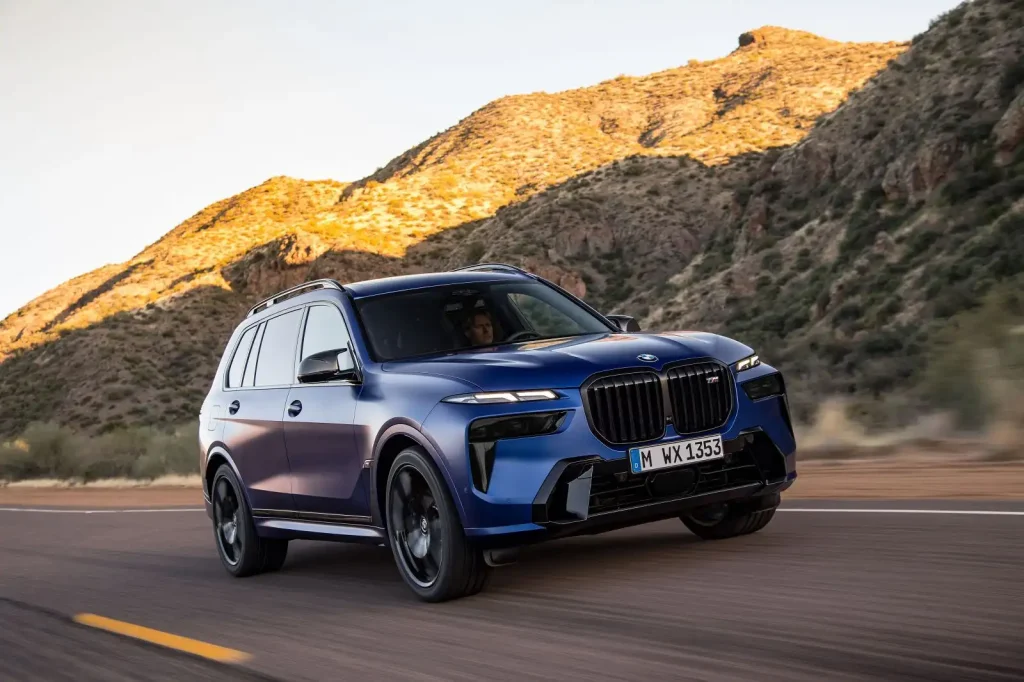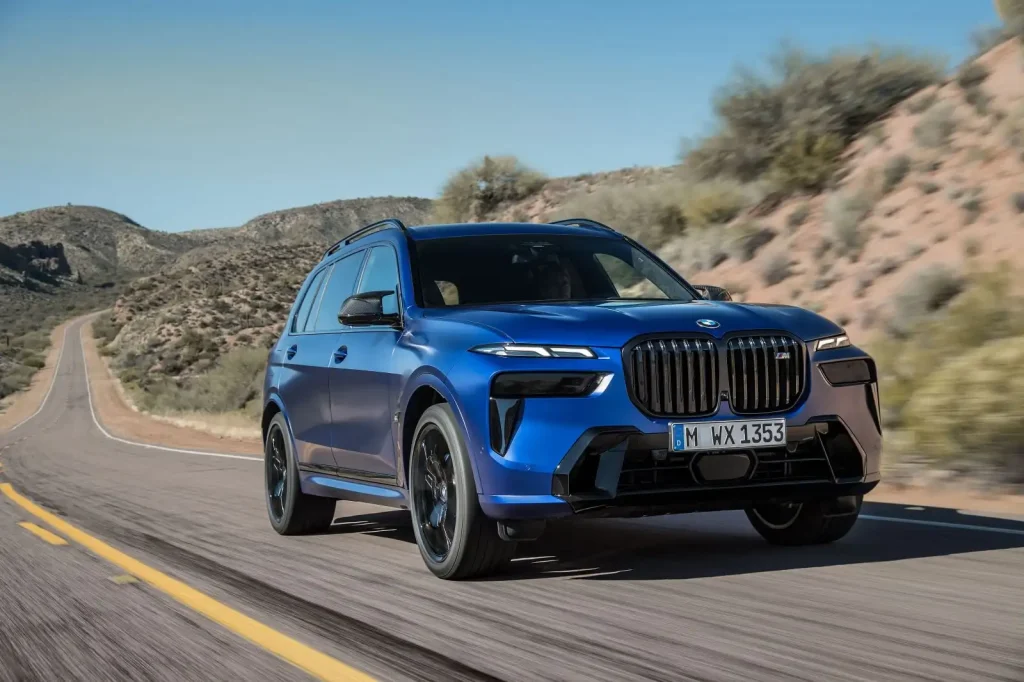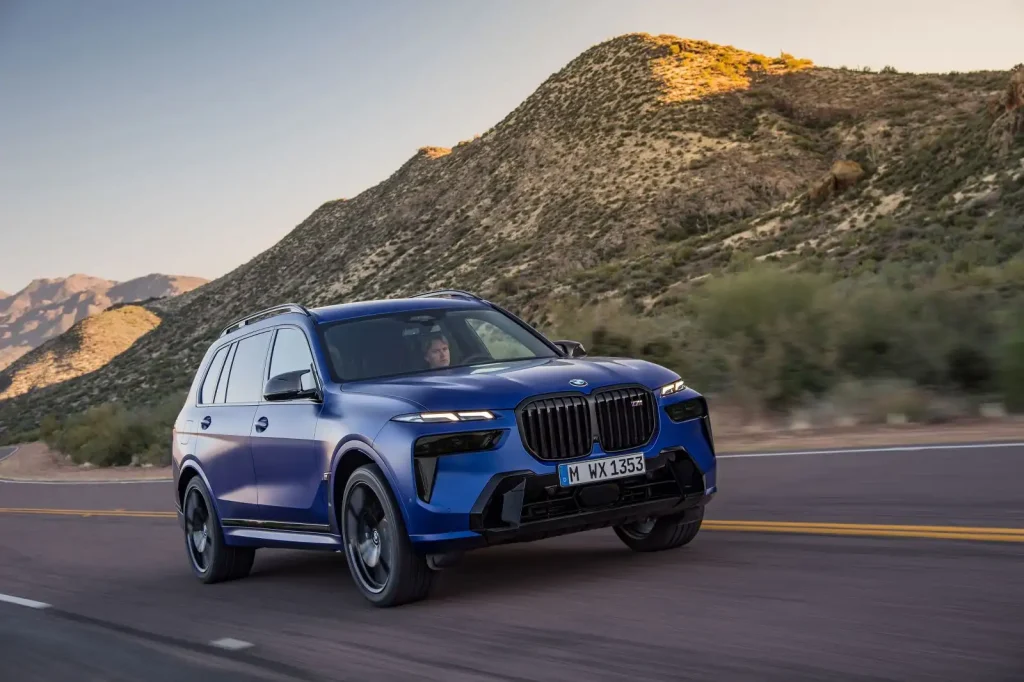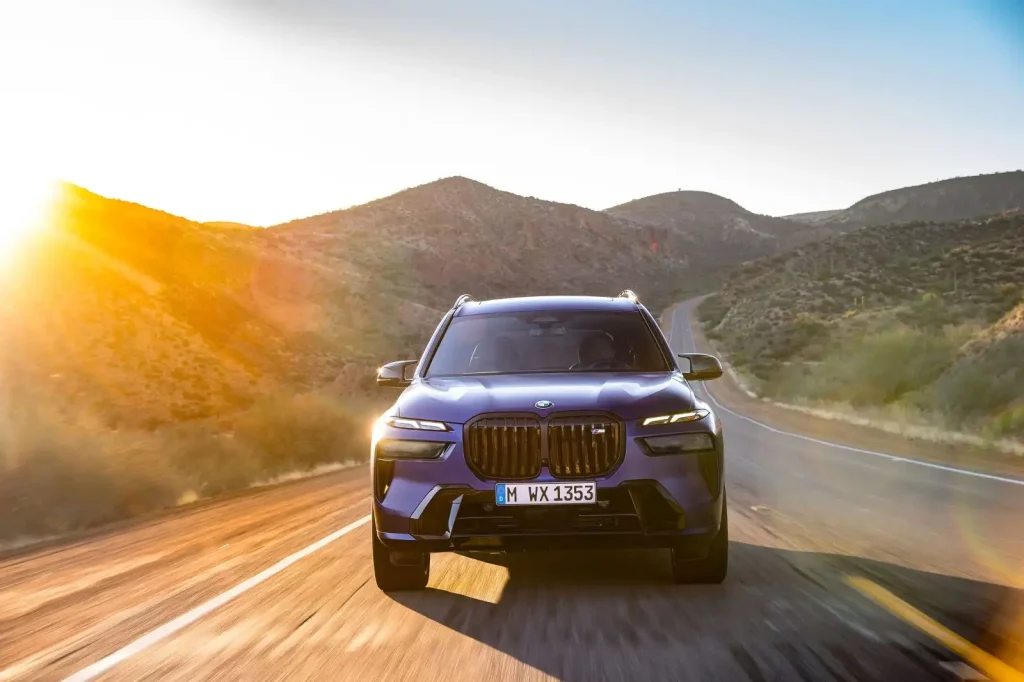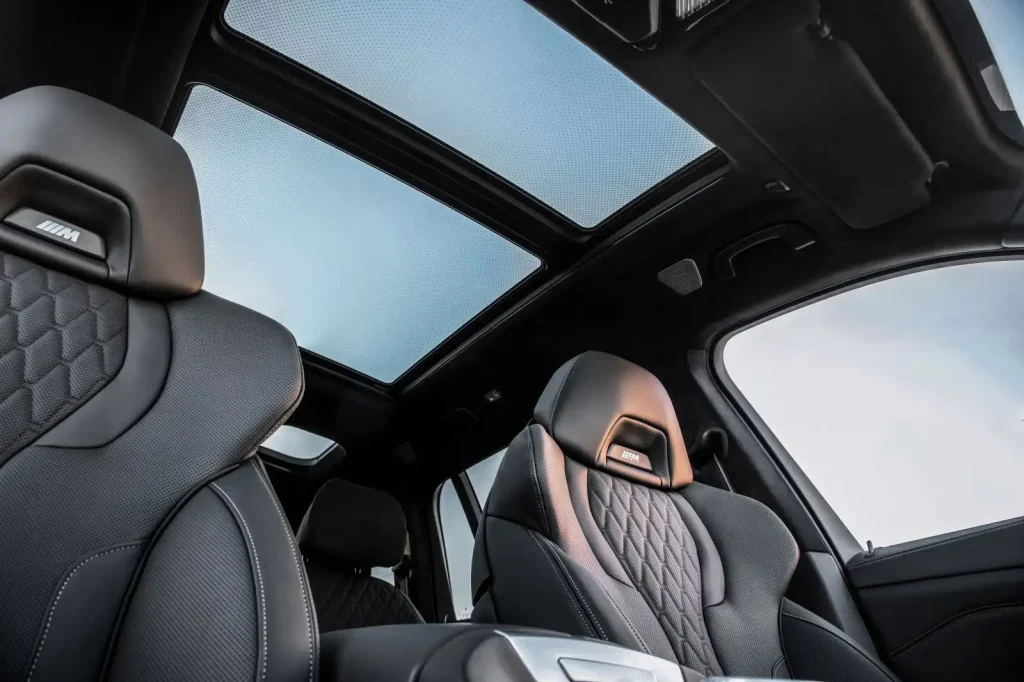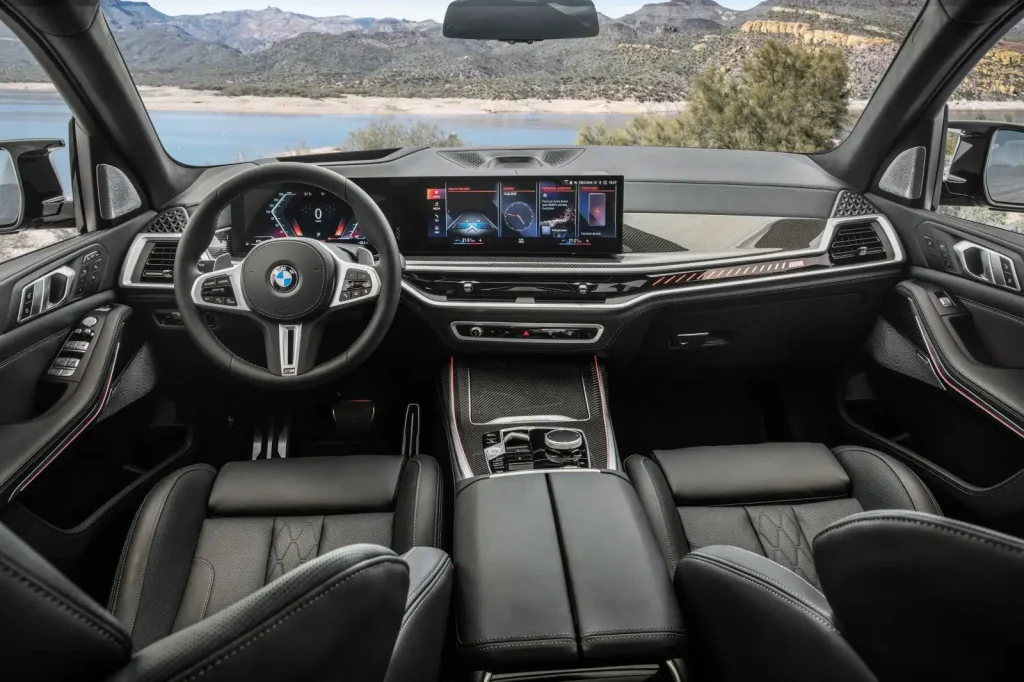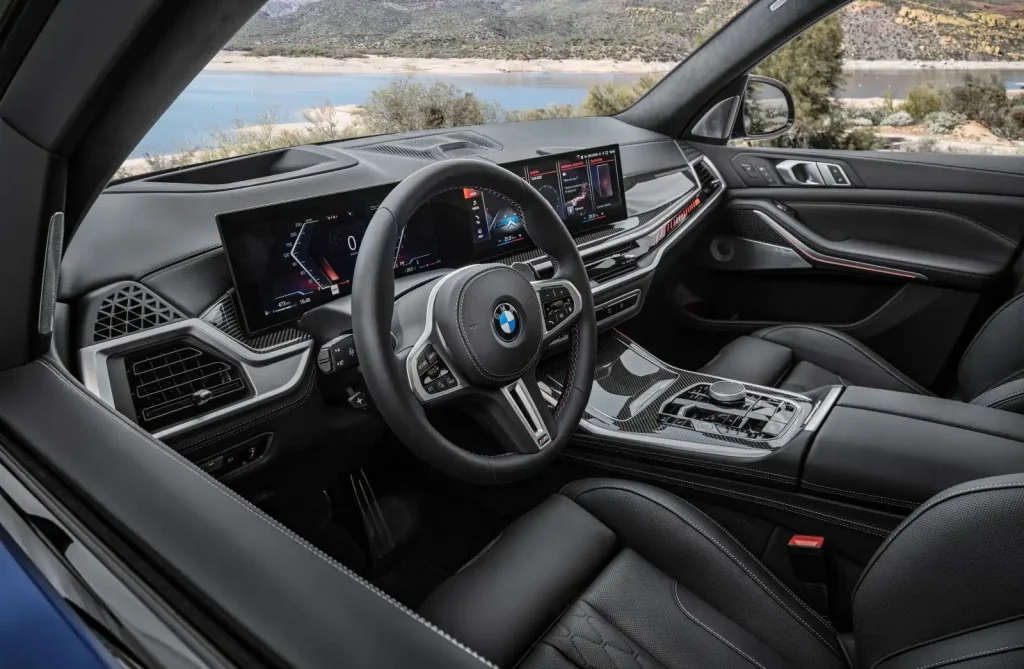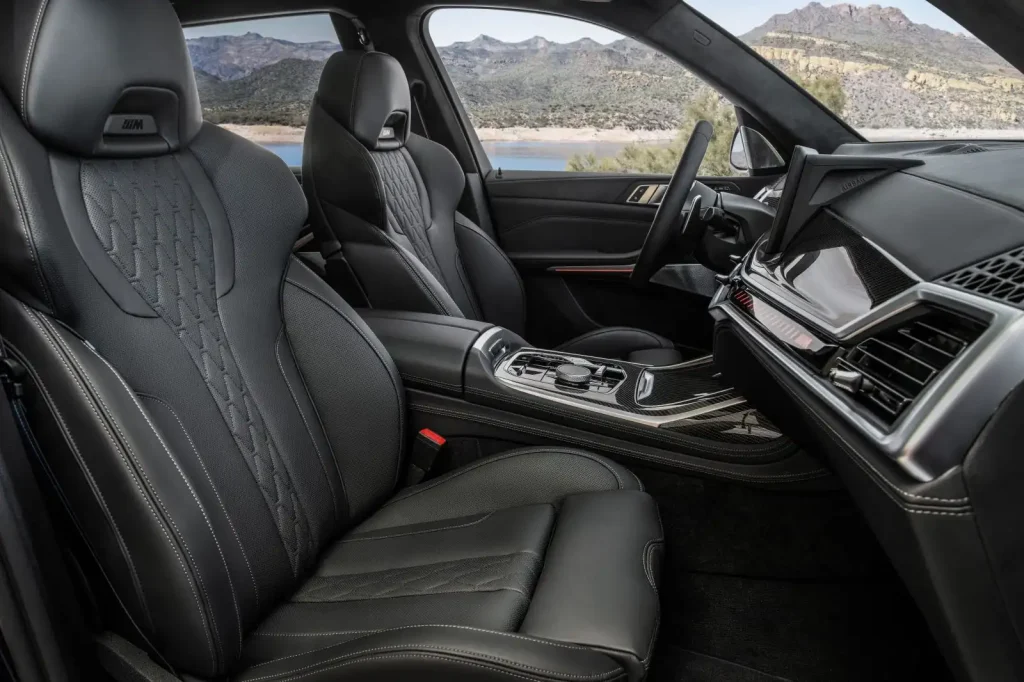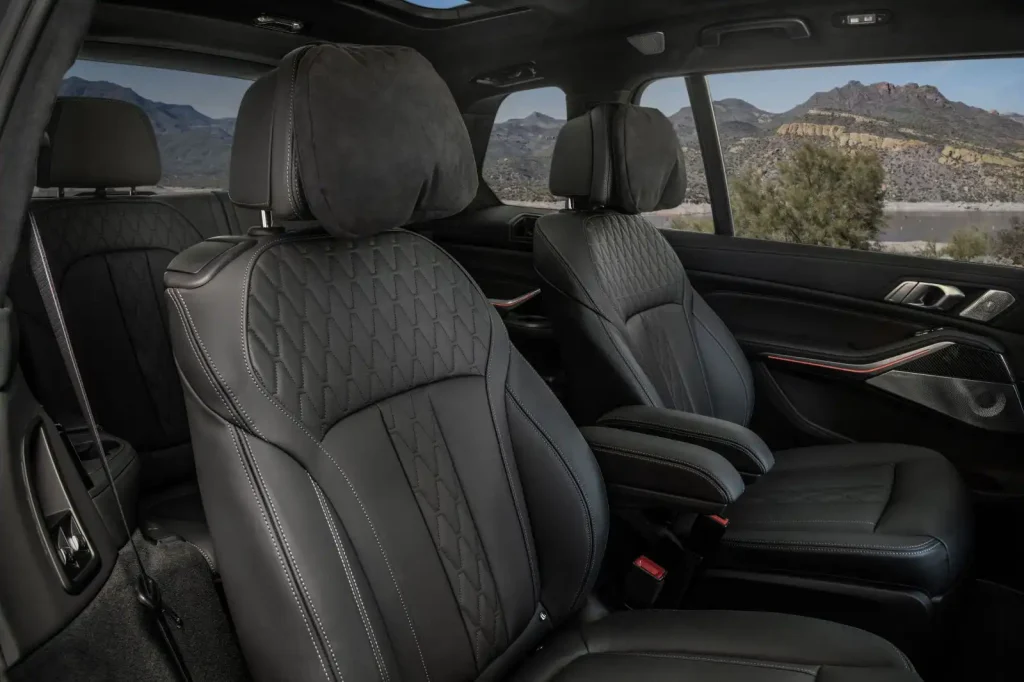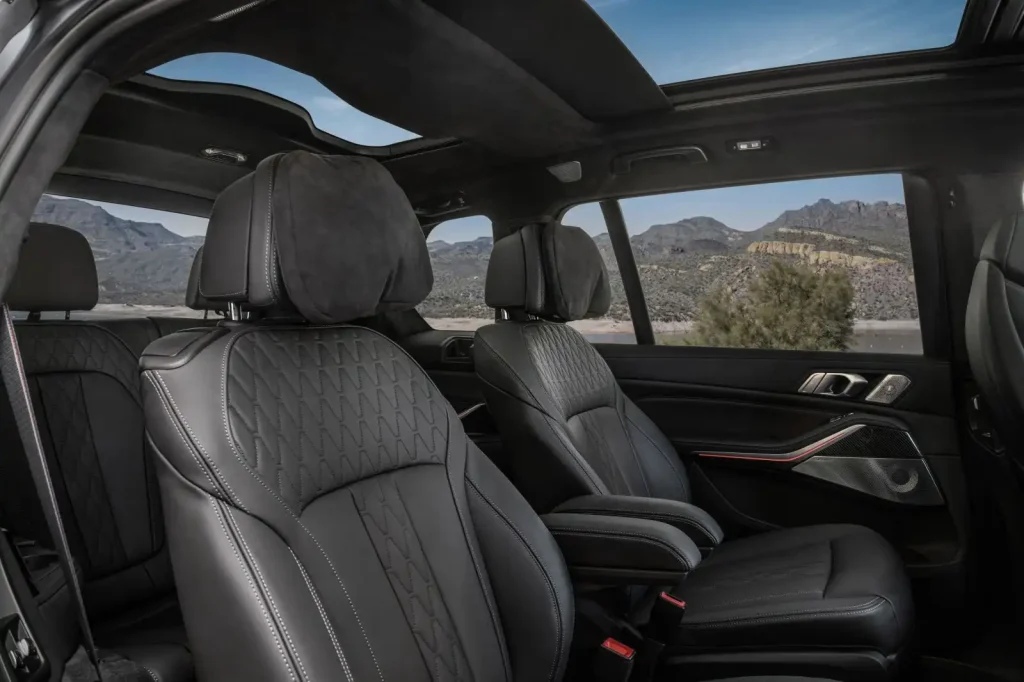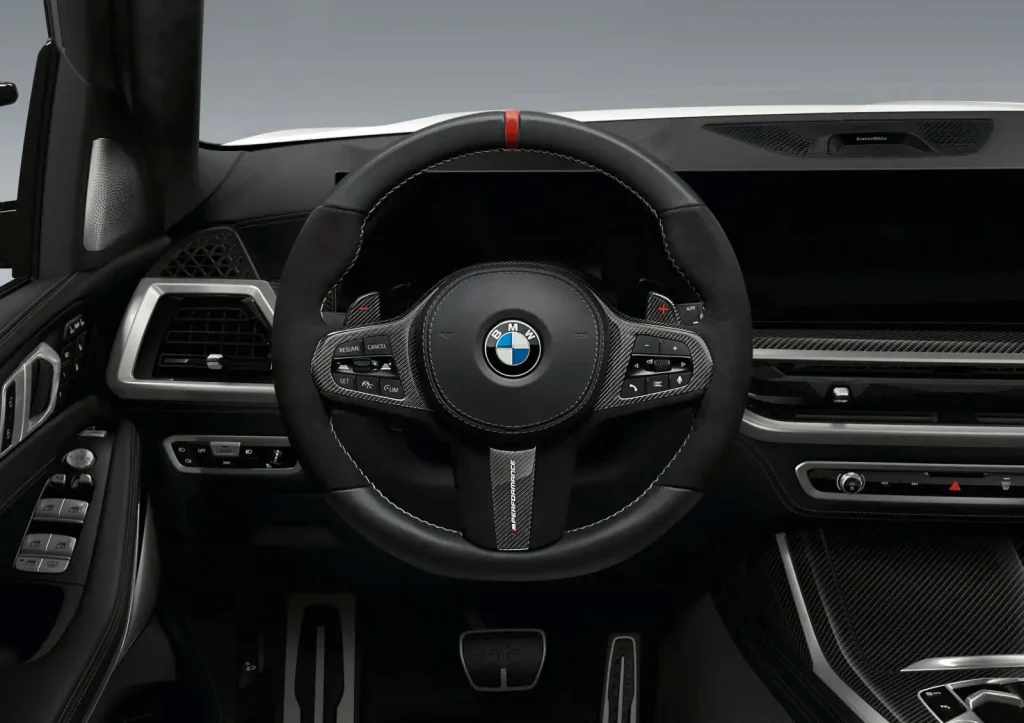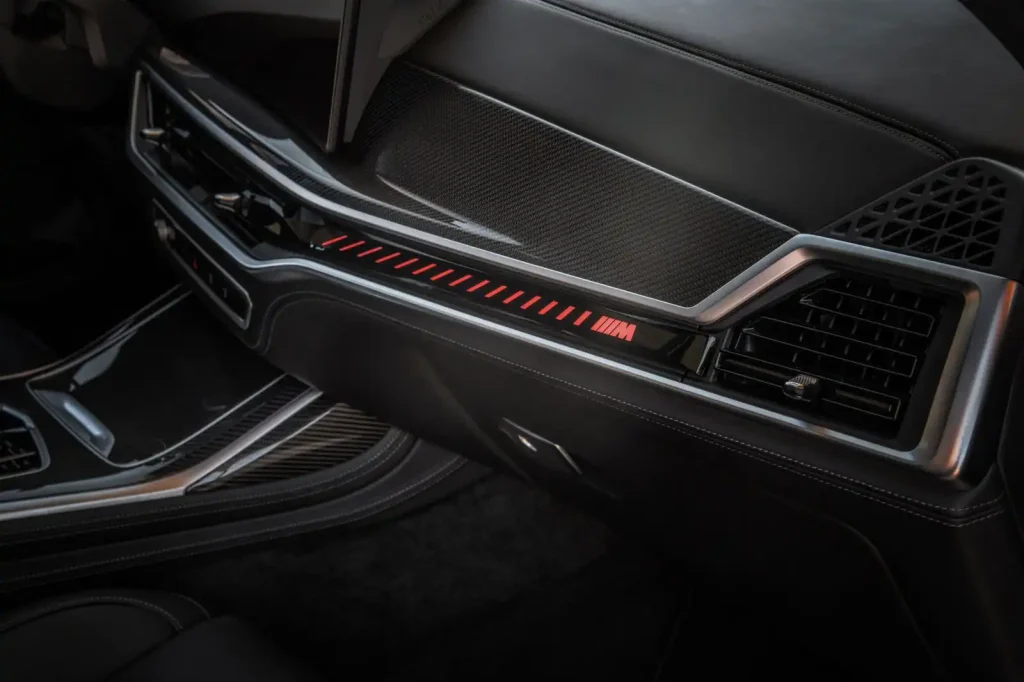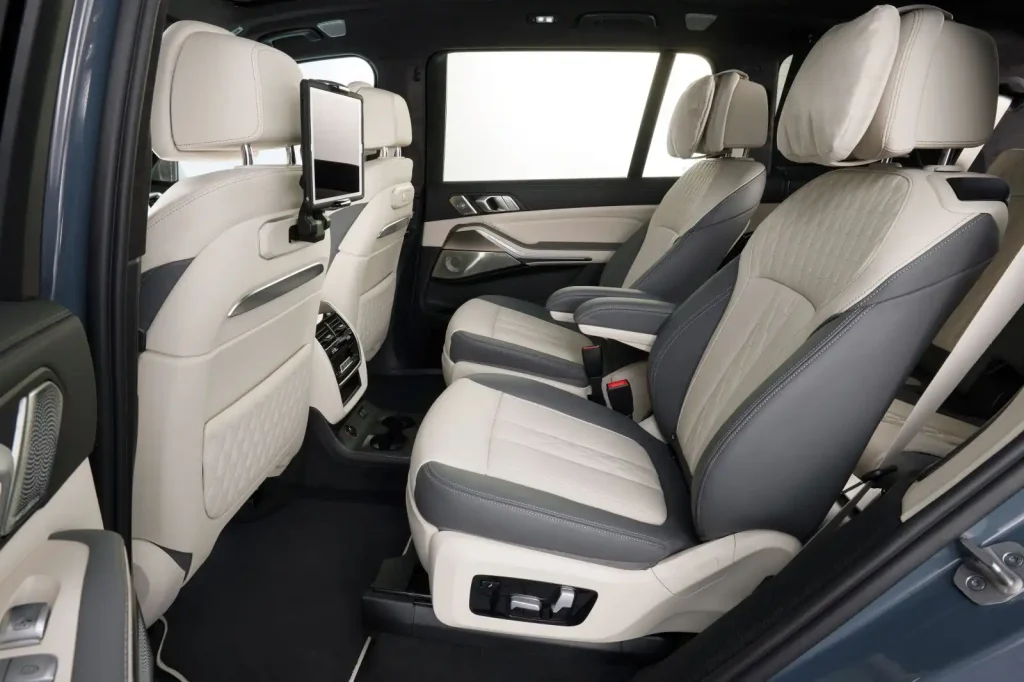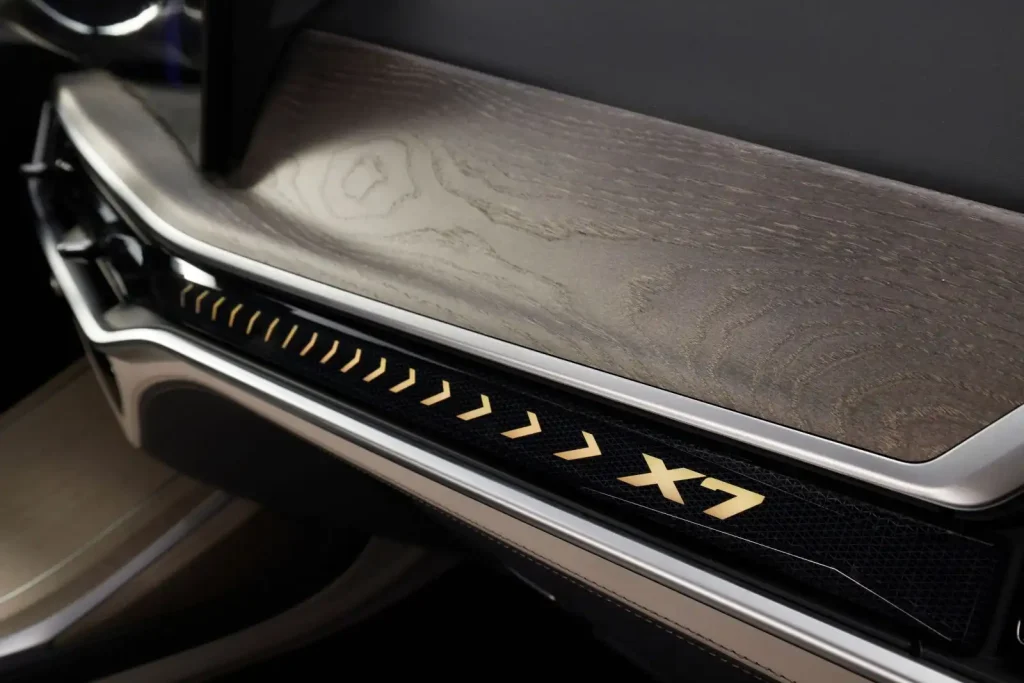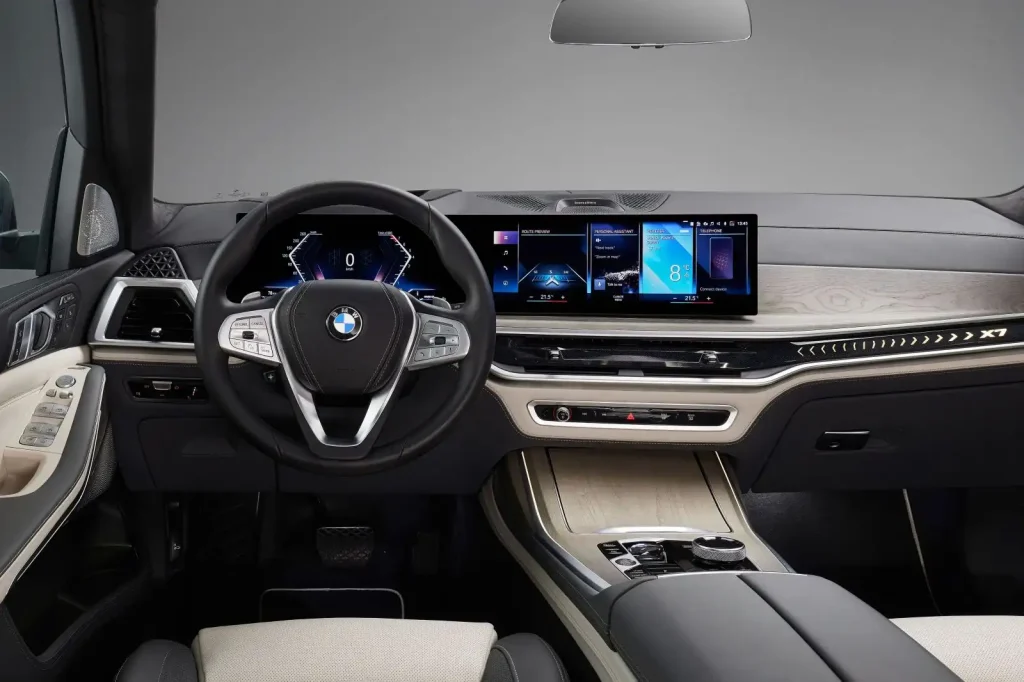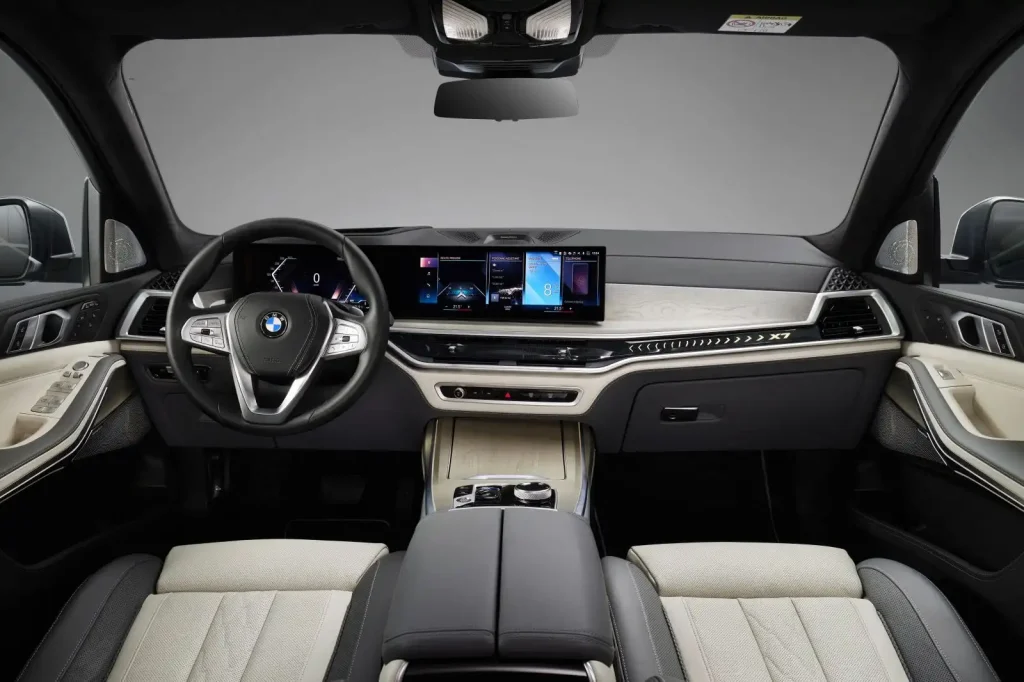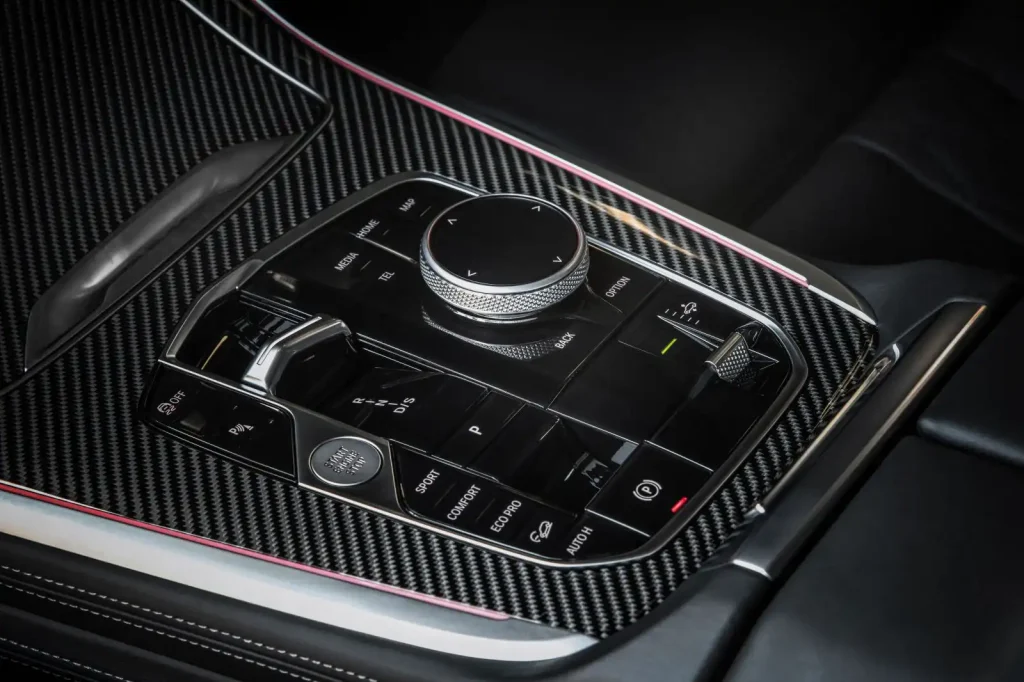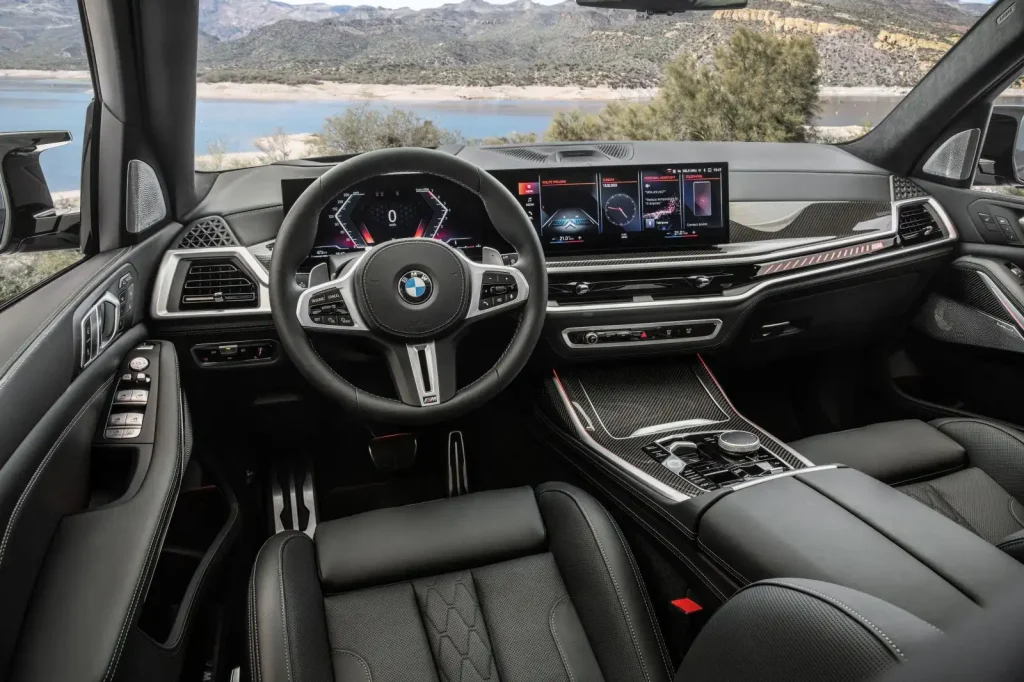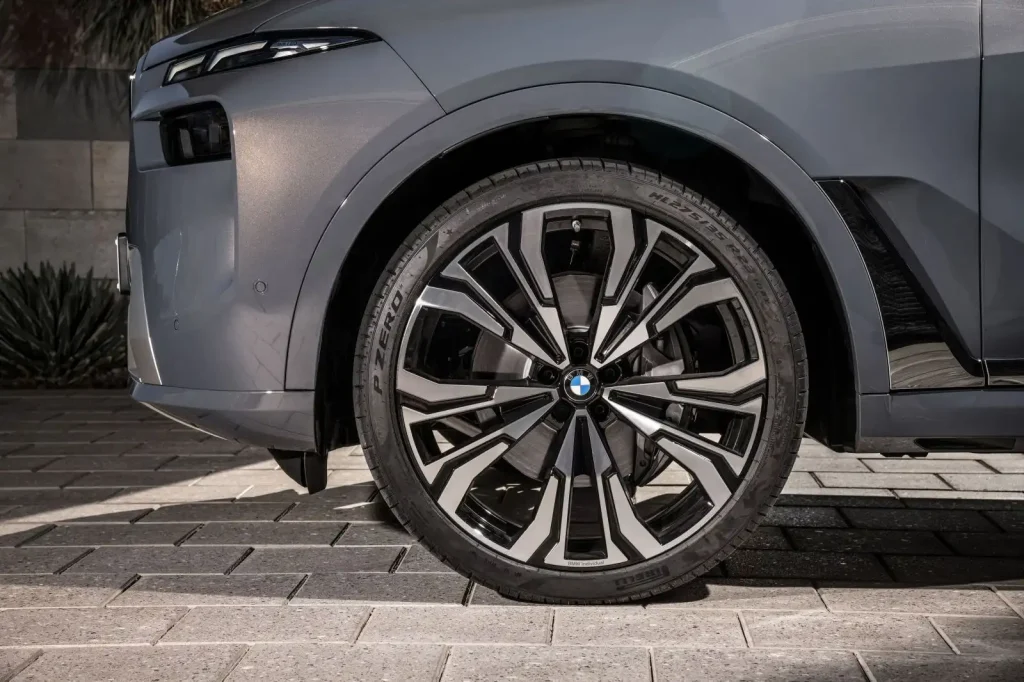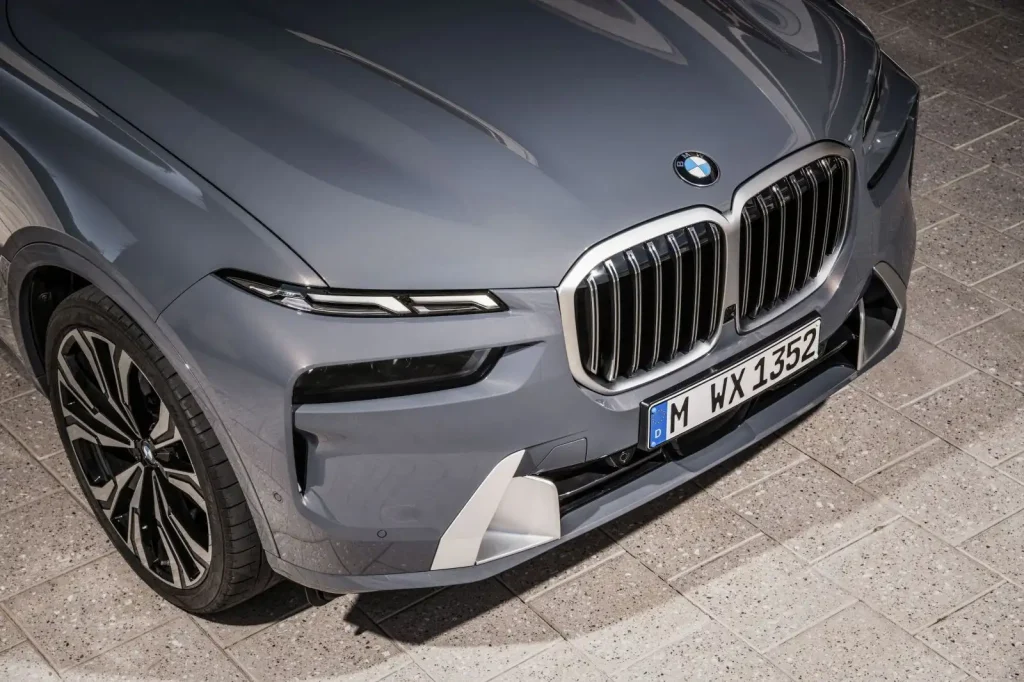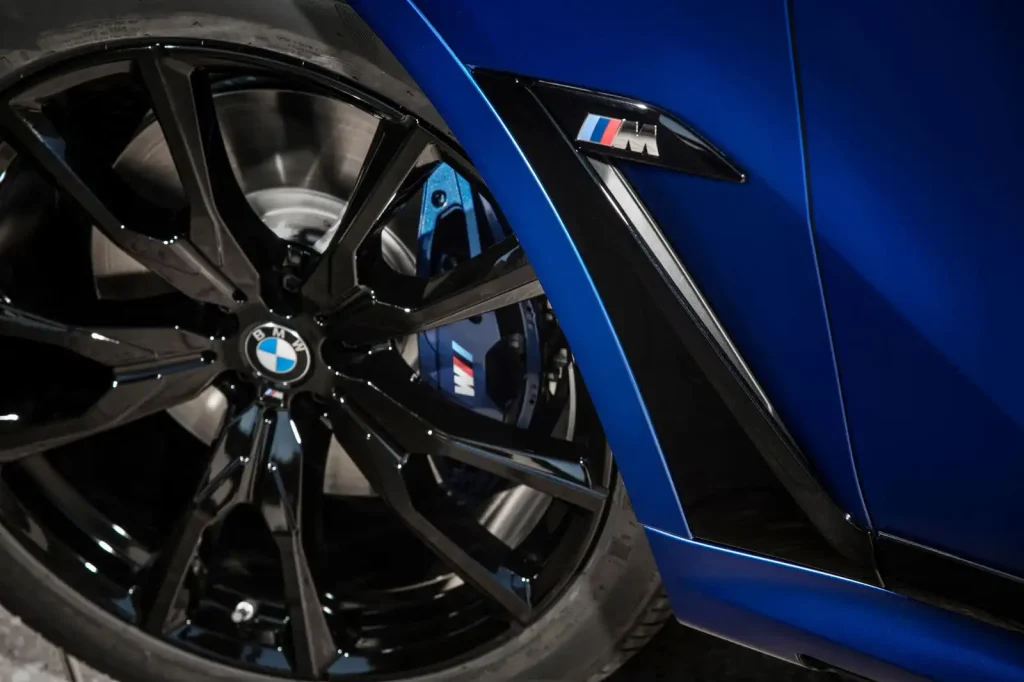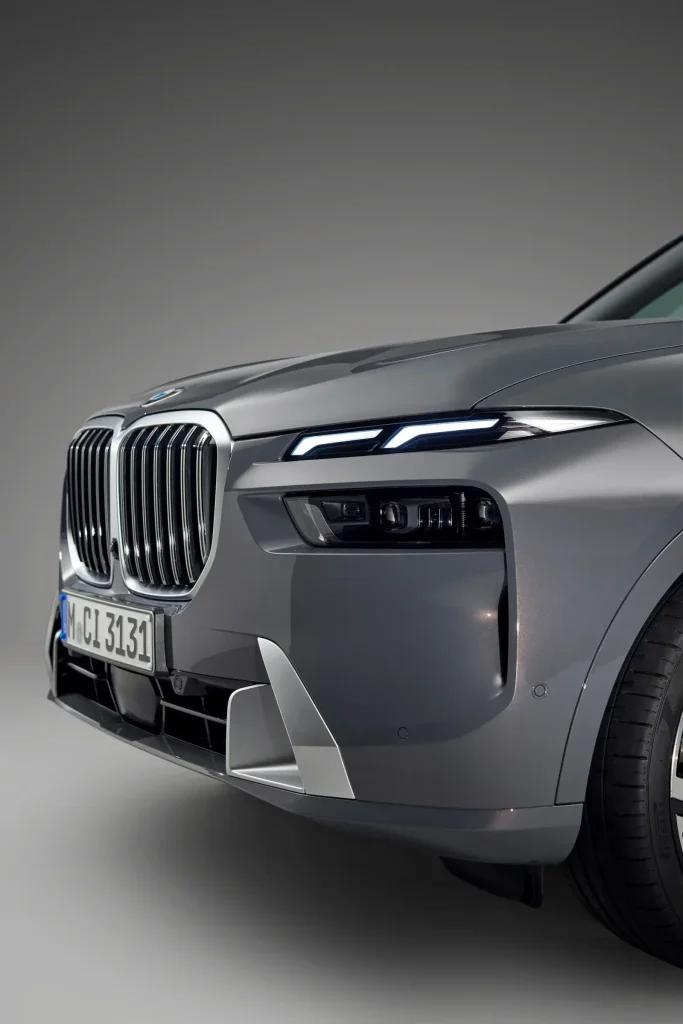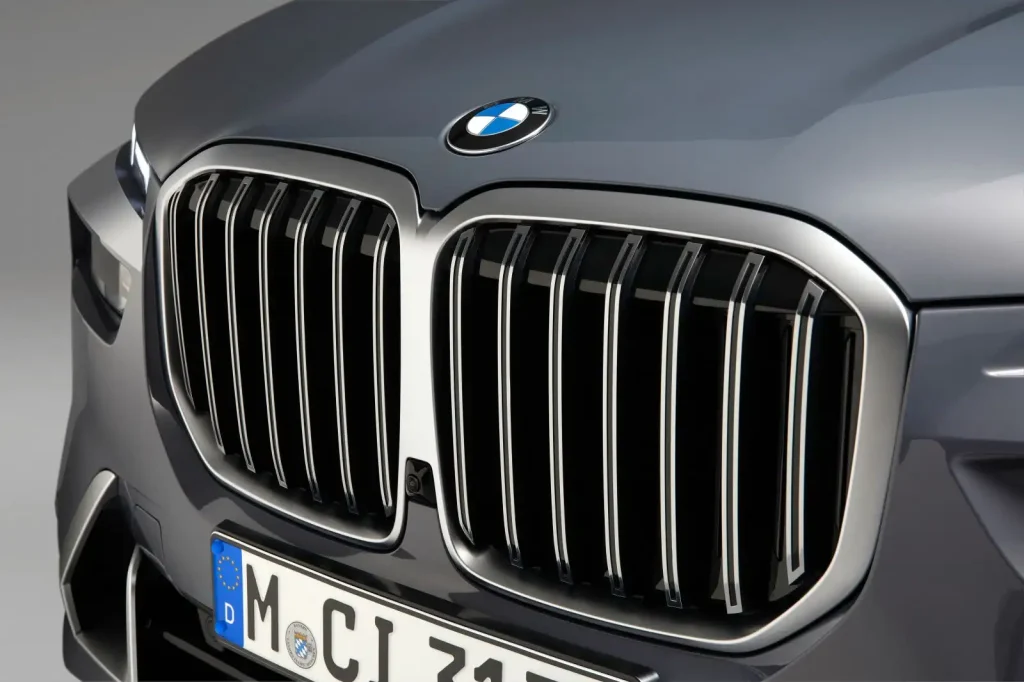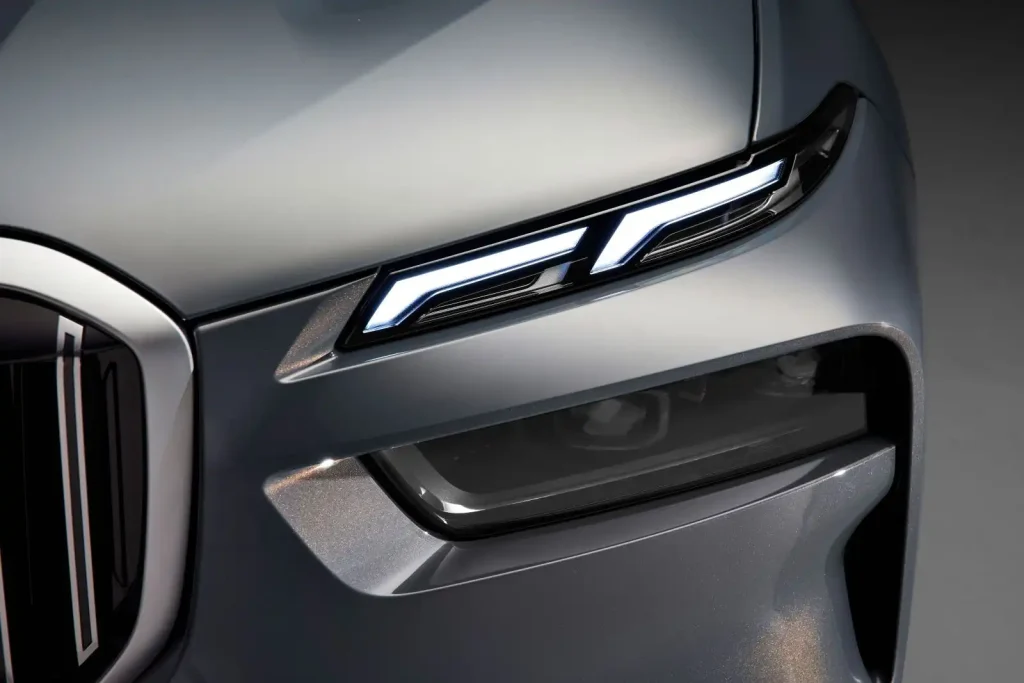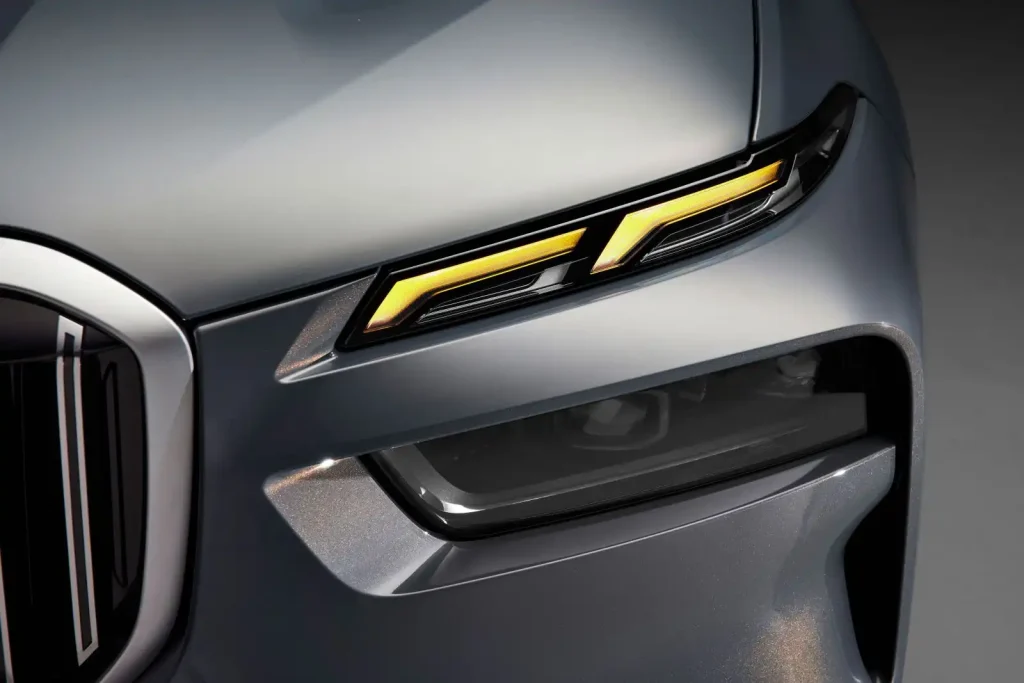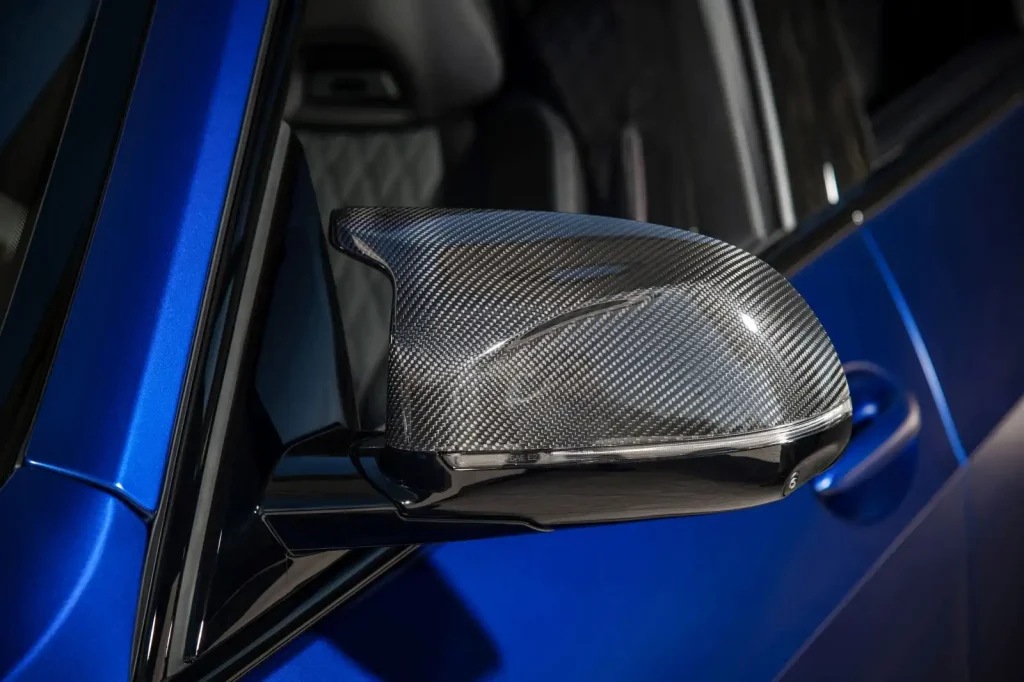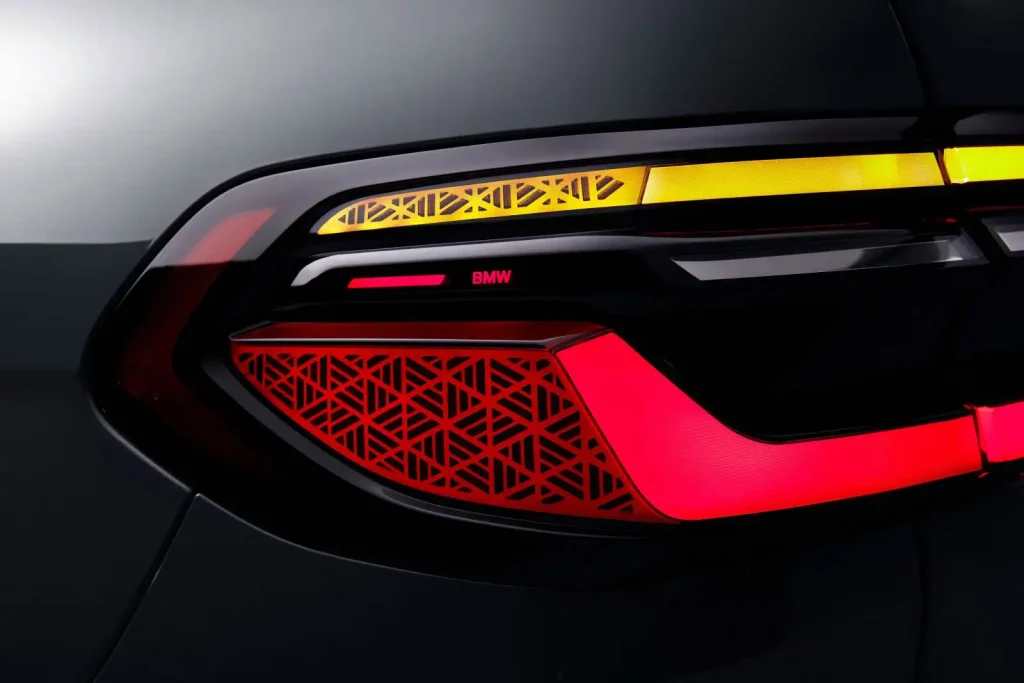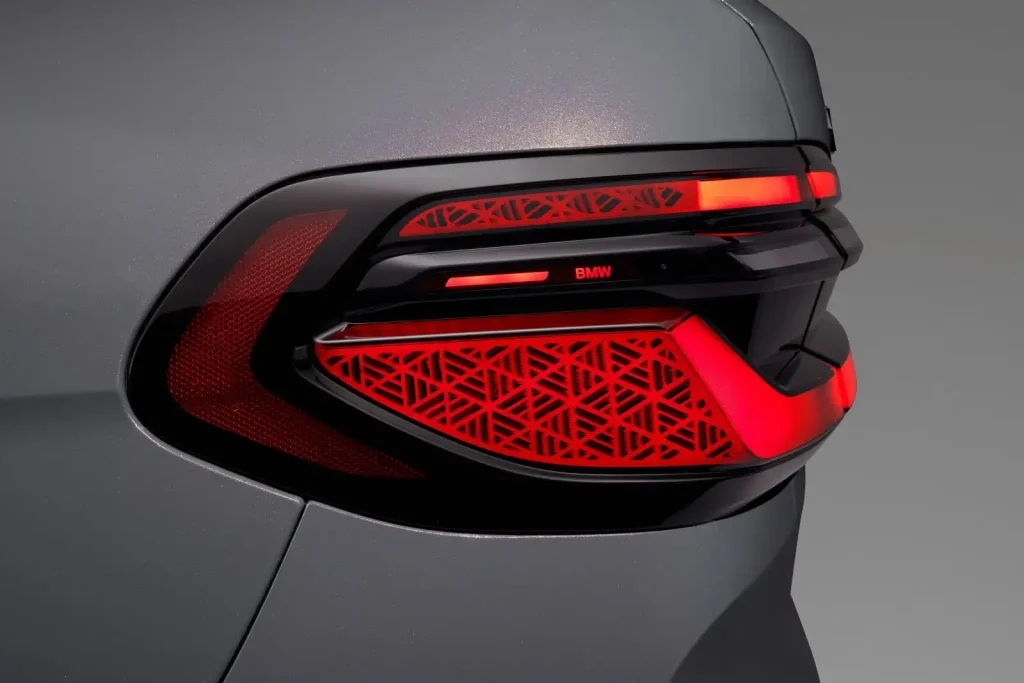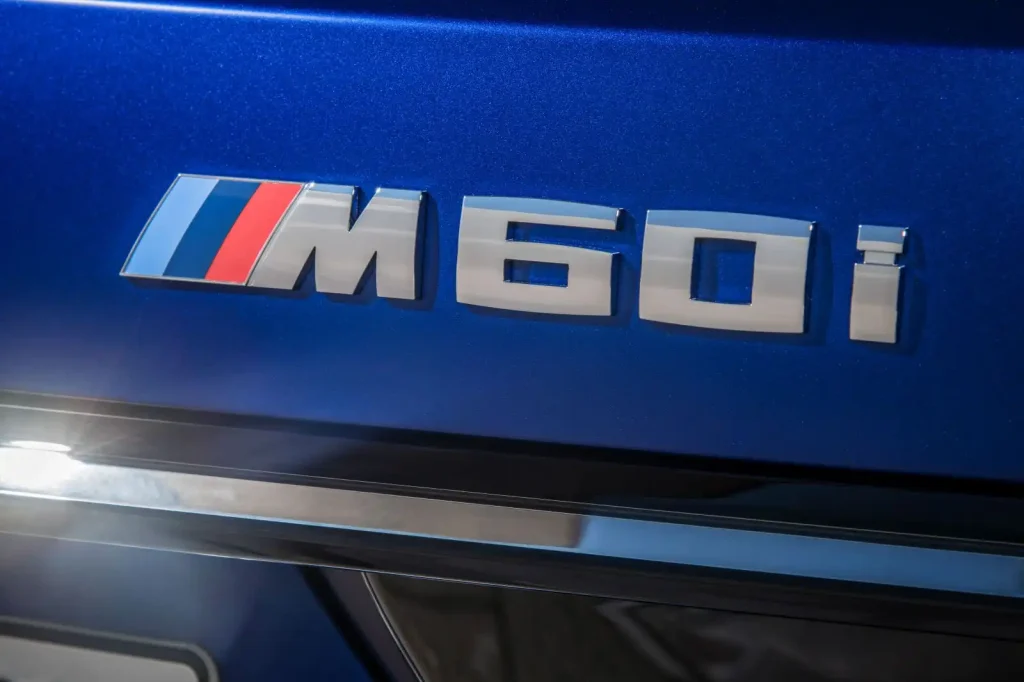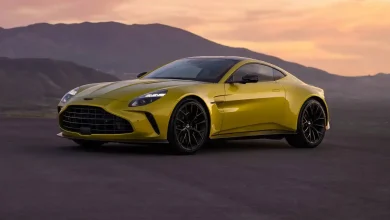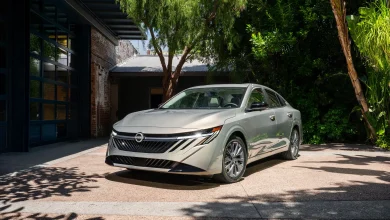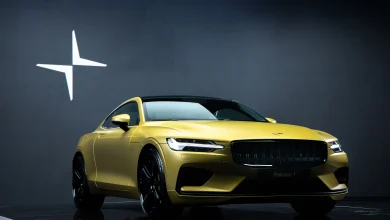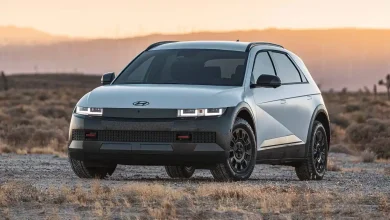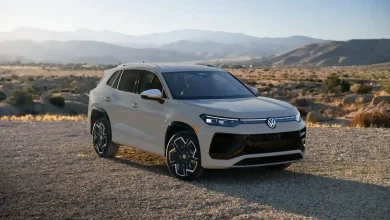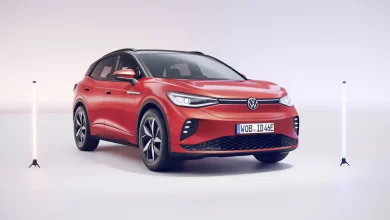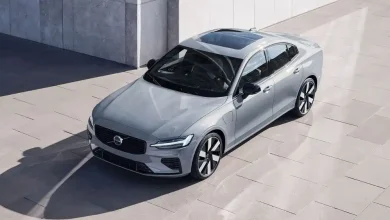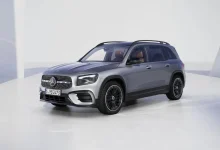- Luxurious and sporty, like a proper BMW
- Powerful yet efficient base I-6 engine
- Quick, capable infotainment system
- Less interior space than competitors
- Difficult to access the third row
- Not exactly pretty
2025 BMW X7 – Overview
The 2025 BMW X7 may have been a latecomer to the full-size luxury SUV segment—launching in 2019—but it quickly earned its place among the elite. Its rich interior, sophisticated air suspension, and comprehensive list of standard features make it a compelling option right out of the gate. What truly sets the X7 apart, however, is its unexpectedly athletic handling and a trio of strong engine choices that outperform many rivals.
At its core, the X7 offers a refined 375-hp turbocharged inline-six that delivers smooth, confident acceleration. Those wanting more punch can upgrade to a potent 523-hp turbocharged V-8, while performance enthusiasts can go all out with the range-topping Alpina XB7 and its monstrous 630-hp twin-turbo V-8. Every model benefits from standard all-wheel drive, ensuring capable traction in all conditions.
Despite its dynamic strengths, the X7 does have limitations—particularly in cargo capacity and third-row legroom, where it falls behind rivals like the Cadillac Escalade and Jeep Grand Wagoneer. Still, the front and middle rows are a sanctuary of comfort, with plush materials, a serene ride, and elegant styling that enhances every journey.
While opinions remain split on its bold, narrow-headlight front design, the X7’s starting price of around $85,000 positions it as a strong value in a segment where oversized proportions often come with equally oversized price tags. It’s no surprise the 2025 BMW X7 continues to earn a place on our Editors’ Choice list—it remains one of the most well-rounded offerings in its class.
When Is The 2025 BMW X7 Coming Out?
The 2025 BMW X7 is currently available at dealerships across the United States. Customers can explore various configurations and options to suit their preferences.
What’s New for 2025 BMW X7 ?
For 2025, the BMW X7 gains a notable enhancement to its available Driving Assistance Professional Package. This advanced system—already capable of enabling hands-free driving at speeds up to 85 mph under appropriate conditions—now includes an innovative, eye-activated lane change feature. When the system recommends a lane change, the driver can approve the maneuver simply by glancing at the corresponding rearview mirror. This replaces the previous method, which required the driver to confirm the change using the turn signal. It’s a small but significant step forward in the evolution of intuitive, semi-autonomous driving technology.
Pricing and Which One to Buy
The 2025 BMW X7 lineup starts at $85,475 and can climb to $153,395, depending on the trim level and optional equipment selected.
While the range-topping M60i and its thrilling twin-turbo V-8 engine certainly hold strong emotional appeal, the significant price jump may not be justifiable for most buyers. For those seeking a balanced blend of performance, luxury, and value, the xDrive40i is the smart choice. Its smooth turbocharged inline-six delivers ample power, and the model comes generously equipped with standard features like four-zone automatic climate control, a panoramic sunroof, heated and power-adjustable front seats with memory settings, and a hands-free power tailgate.
We recommend enhancing the xDrive40i with Vernasca leather upholstery for a richer interior feel. Additionally, the available Premium Package brings added niceties such as a head-up display, soft-close doors, and gesture controls—though in our experience, the gesture control system tends to be finicky and isn’t essential for most users.
Engine, Transmission, and Performance
The 2025 BMW X7 offers a trio of powerful engines, each delivering a distinct driving experience. The base xDrive40i model features a silky-smooth 375-hp turbocharged inline-six, providing more than enough muscle for everyday driving and long-haul comfort. Step up to the M60i, and you’ll find a twin-turbocharged 4.4-liter V-8 pumping out 523 horsepower, bringing a deeper exhaust note and noticeably sharper acceleration.
For those chasing the ultimate performance SUV experience, the Alpina XB7 crowns the lineup with a specially tuned version of the V-8, pushing a staggering 630 horsepower. All X7 models are paired with an eight-speed automatic transmission and standard all-wheel drive, delivering smooth shifts and confident grip in a variety of conditions.
Every X7 rides on a standard air suspension with adaptive dampers, ensuring a plush ride in most scenarios. For drivers seeking even more precision and composure, rear-axle steering and active anti-roll stabilization are available—and come standard on the M60i—enhancing agility and minimizing body roll during spirited cornering. Unsurprisingly, the M60i benefits from a sport-tuned suspension setup that underscores its performance pedigree.
Despite its size, the X7 handles with unexpected poise. The steering is responsive, well-weighted, and offers a sense of control rarely found in full-size luxury SUVs. While the standard 21-inch wheels provide a good balance between comfort and style, optional 23-inch wheels are available for a bolder look—though they come at the expense of ride quality, especially on rougher pavement.
0–60 MPH Times
Don’t let the BMW X7’s size fool you—this luxury SUV moves with real urgency. In testing, the xDrive40i sprinted from 0 to 60 mph in just 4.6 seconds, an impressive feat for a six-cylinder-powered vehicle of this size. Step up to the V-8–equipped M60i, and acceleration becomes even more exhilarating, with a blistering 3.8-second dash to 60 mph. Whether you’re merging onto the freeway or overtaking slower traffic, the X7 delivers swift and confident performance at every level.
Fuel Economy and Real-World MPG
For a full-size luxury SUV, the 2025 BMW X7 offers commendable efficiency—especially in its base configuration. The xDrive40i, powered by the turbocharged inline-six, earns EPA estimates of 21 mpg in the city and 25 mpg on the highway, making it one of the more fuel-conscious choices in its class.
Predictably, the more powerful M60i with its twin-turbo V-8 is thirstier, rated at 16 mpg city and 21 mpg highway by the EPA. However, in real-world testing, the M60i exceeded expectations, achieving 23 mpg on our 75-mph highway fuel economy loop—a surprising result given its power and performance.
For the most current and detailed fuel economy data, you can visit: the official EPA website.
Interior, Comfort, and Cargo
Step inside the 2025 BMW X7, and you’re greeted by a cabin that blends cutting-edge technology with classic luxury. Dominating the dashboard is a gently curved digital display that spans nearly the entire width of the front row. It includes a 12.3-inch digital instrument cluster and a 14.9-inch touchscreen that handles infotainment duties, all powered by BMW’s latest iDrive system.
Standard luxury features abound, including heated front seats, a panoramic sunroof, ambient interior lighting, and a power-adjustable steering wheel—all designed to elevate the driving experience. Materials throughout the cabin are top-notch, and the overall fit and finish rival those of more expensive SUVs.
However, there are a few quirks. The power-operated second-row captain’s chairs, while convenient in concept, are frustratingly slow when trying to access the third row. And although the third-row seats are usable, adult passengers may find them cramped on longer trips. That said, comfort in the first two rows is exceptional, with generous space, plush seating, and quiet refinement making it ideal for extended journeys.
When it comes to practicality, the X7 delivers solid versatility. Interior storage is plentiful, with smartly designed cubbies throughout the cabin. While there’s only enough space behind the third row for three carry-on suitcases, folding the second and third rows opens up a cavernous cargo area that accommodated 33 carry-ons in our testing—making it a flexible companion for road trips or bulk hauls.
Infotainment and Connectivity
Tech-savvy luxury meets thoughtful design in the 2025 BMW X7’s infotainment setup. At the heart of the system is a 14.9-inch touchscreen seamlessly integrated into a curved glass display that also houses the 12.3-inch digital instrument cluster. Powered by BMW’s latest iDrive interface, the system offers a responsive and visually rich user experience.
Drivers can interact with the system in several ways: via touchscreen controls, a rotary iDrive controller on the center console, or even gesture controls—though the latter often feel more like a novelty than a practical feature.
Standard tech includes a Wi-Fi hotspot (subscription required) and access to BMW’s Digital Key, which lets users remotely unlock, start, and control key vehicle functions from a smartphone. Optional upgrades include a crystal-clear Harman/Kardon premium audio system and wireless device charging, adding further convenience and refinement to the high-tech cabin.
Safety and Driver-Assistance Features
The 2025 BMW X7 comes well-equipped with a comprehensive suite of standard driver-assistance technologies designed to enhance safety and peace of mind on the road. Key features include:
-
Forward-collision warning with automated emergency braking
-
Blind-spot monitoring and rear cross-traffic alert
-
Lane-departure warning
In addition to these standard systems, several advanced safety options are available to further bolster driver confidence. For detailed information on crash test ratings and safety performance, you can visit the National Highway Traffic Safety Administration (NHTSA) and Insurance Institute for Highway Safety (IIHS) websites.
Warranty and Maintenance Coverage
BMW pairs its competitive limited and powertrain warranties with an above-average complimentary scheduled maintenance program, providing added value and peace of mind for 2025 X7 owners.
-
Limited warranty: Covers four years or 50,000 miles
-
Powertrain warranty: Covers four years or 50,000 miles
-
Complimentary scheduled maintenance: Included for three years or 36,000 miles
2025 BMW X7 – Full Specifications
| Specification | xDrive40i | M60i |
|---|---|---|
| Engine | 3.0L Turbo I6 (Mild Hybrid) | 4.4L Twin-Turbo V8 (Mild Hybrid) |
| Horsepower | 375 hp | 523 hp |
| Torque | 398 lb-ft | 553 lb-ft |
| Transmission | 8-speed Automatic | 8-speed Automatic |
| Drivetrain | All-Wheel Drive (xDrive) | All-Wheel Drive (xDrive) |
| 0–60 MPH | ~5.6 seconds | ~4.5 seconds |
| Fuel Economy (City/Hwy) | 20/24 MPG | 16/20 MPG |
| Seating Capacity | 6 or 7 | 6 or 7 |
| Cargo Capacity | Up to 90.4 cubic feet | Up to 90.4 cubic feet |
| Starting MSRP | $84,300 | $111,900 |
Final Verdict
The 2025 BMW X7 stands out as a top-tier luxury SUV, offering a harmonious blend of performance, comfort, and advanced technology. Its spacious interior, robust engine options, and comprehensive safety features make it a compelling choice for discerning buyers seeking a premium three-row SUV.
2025 BMW X7 Videos
